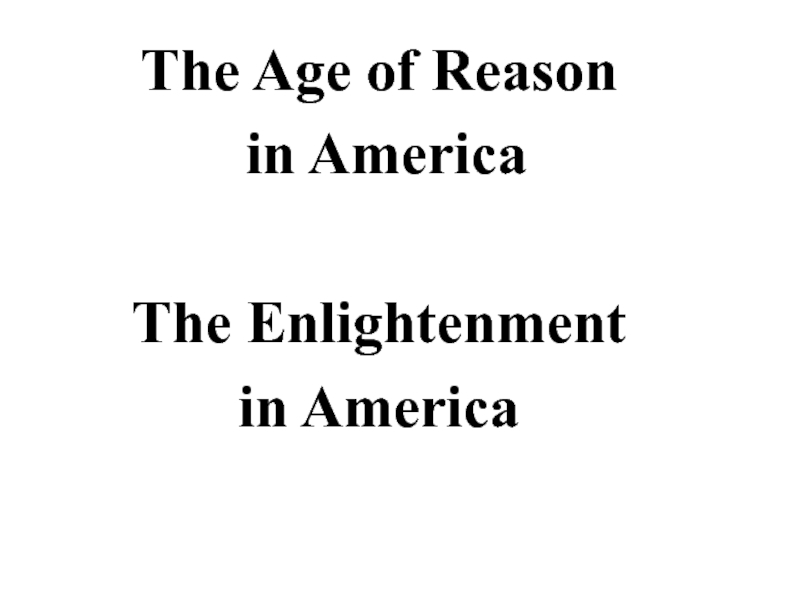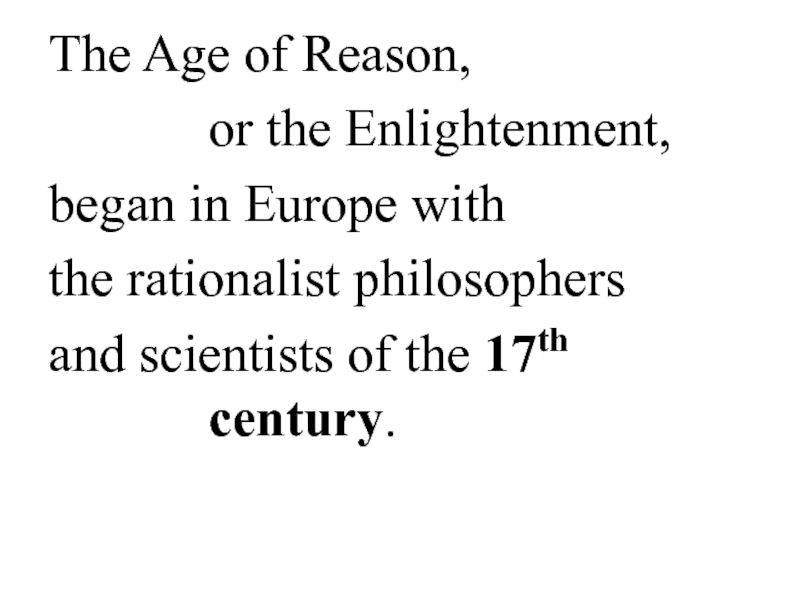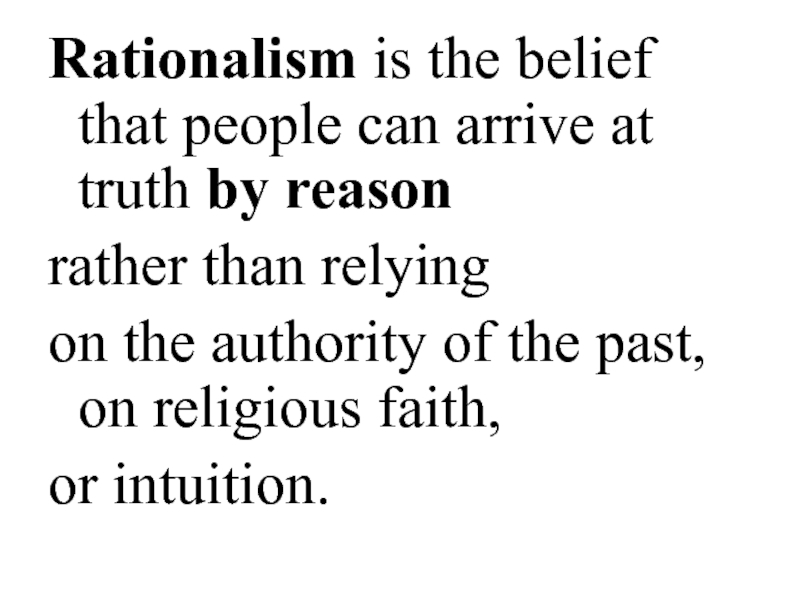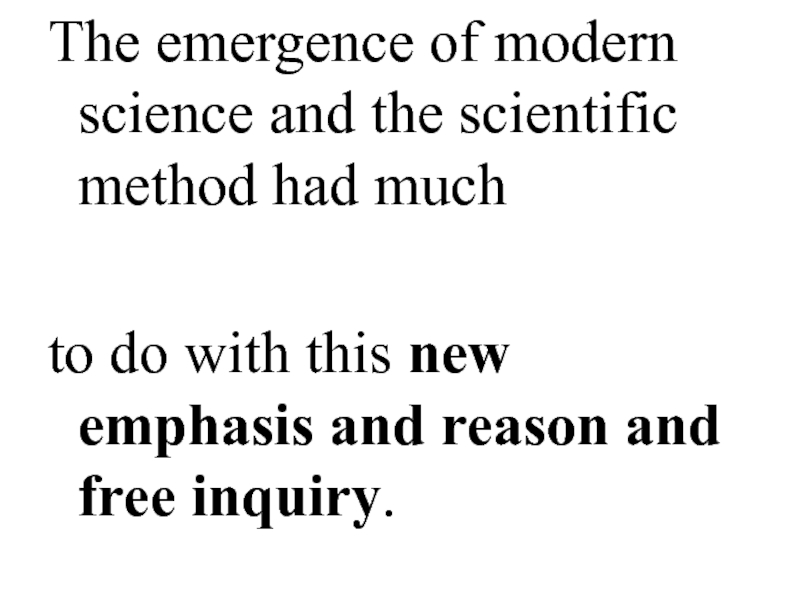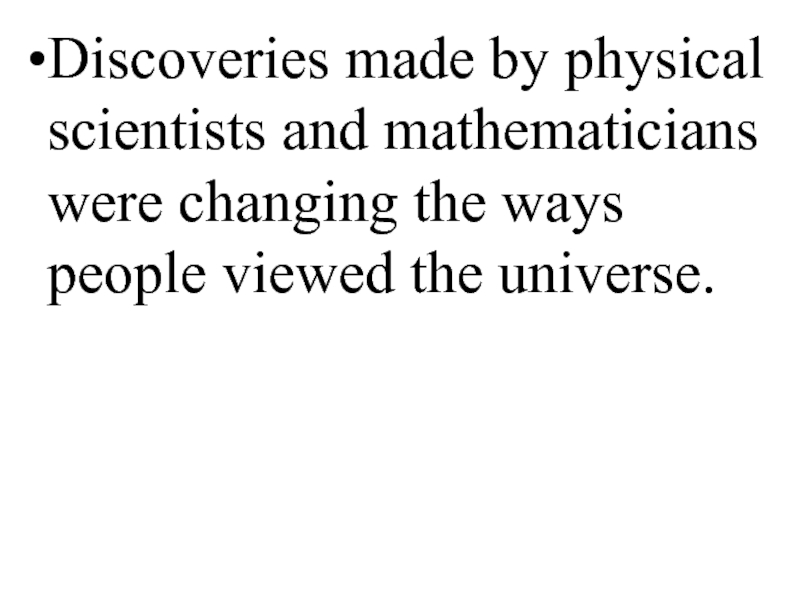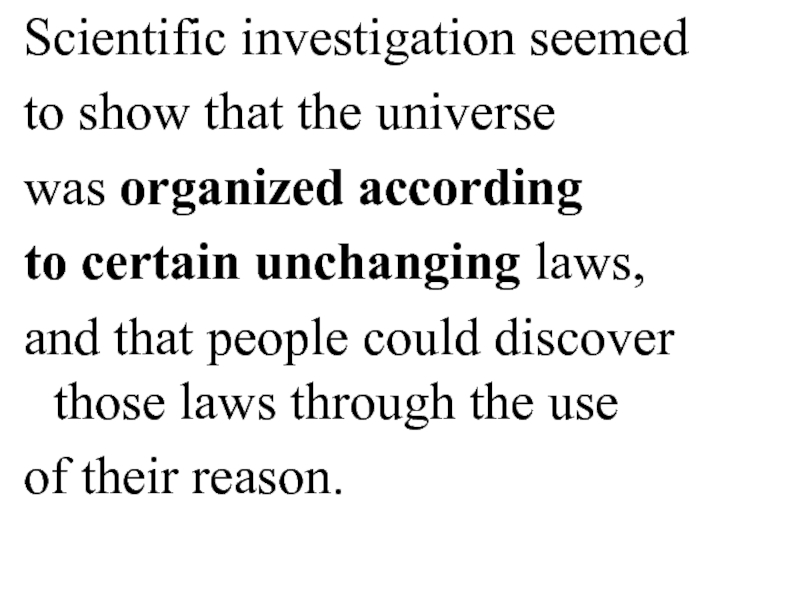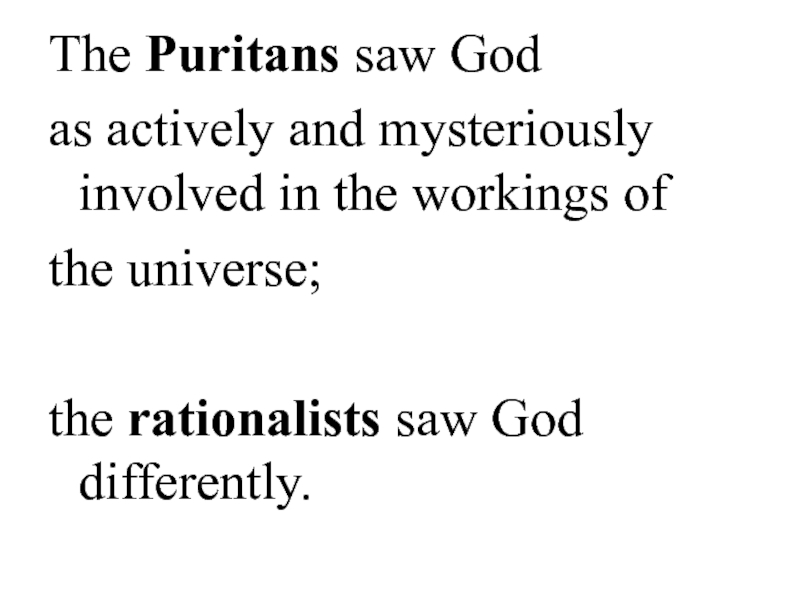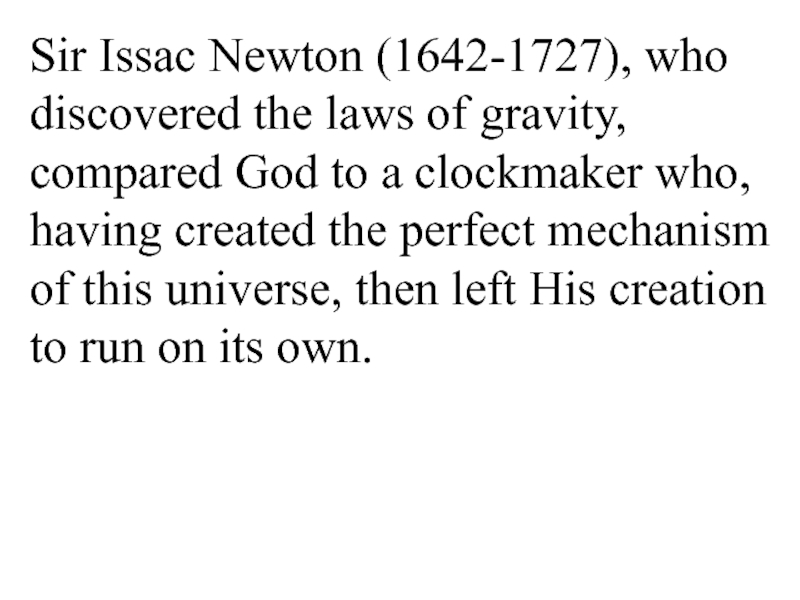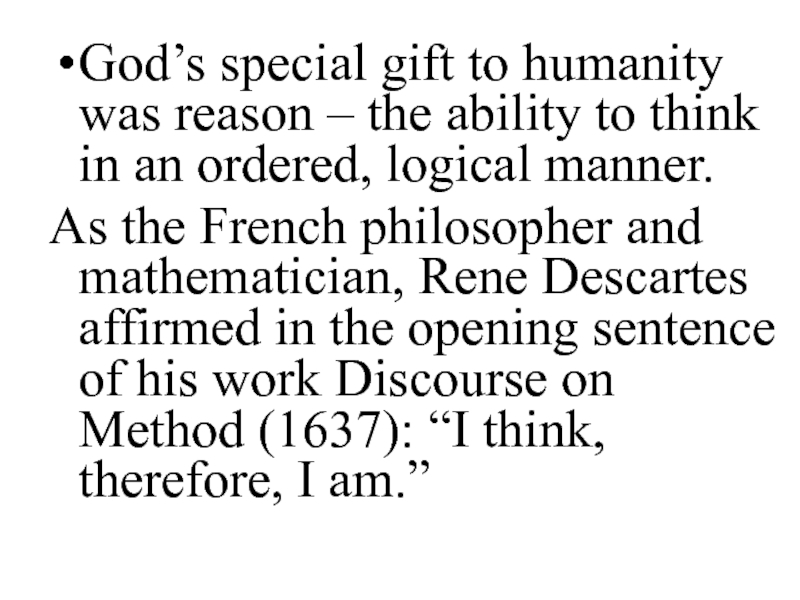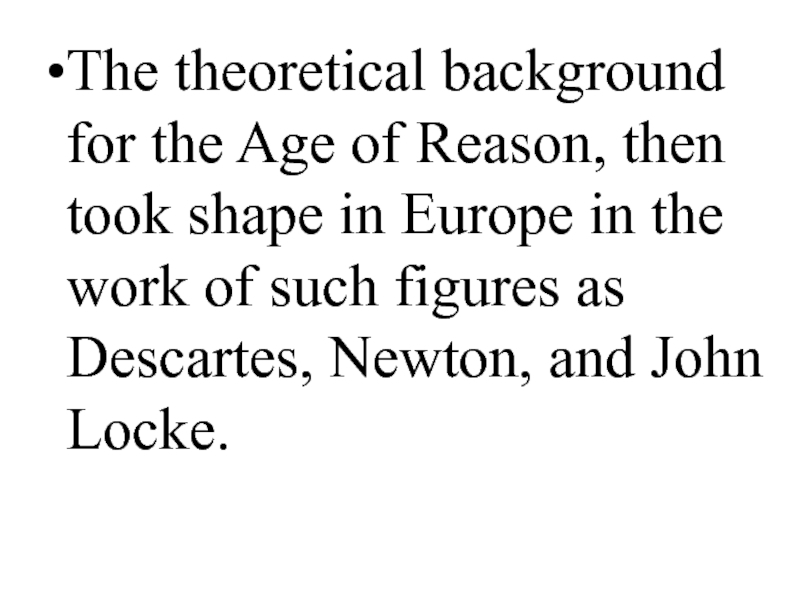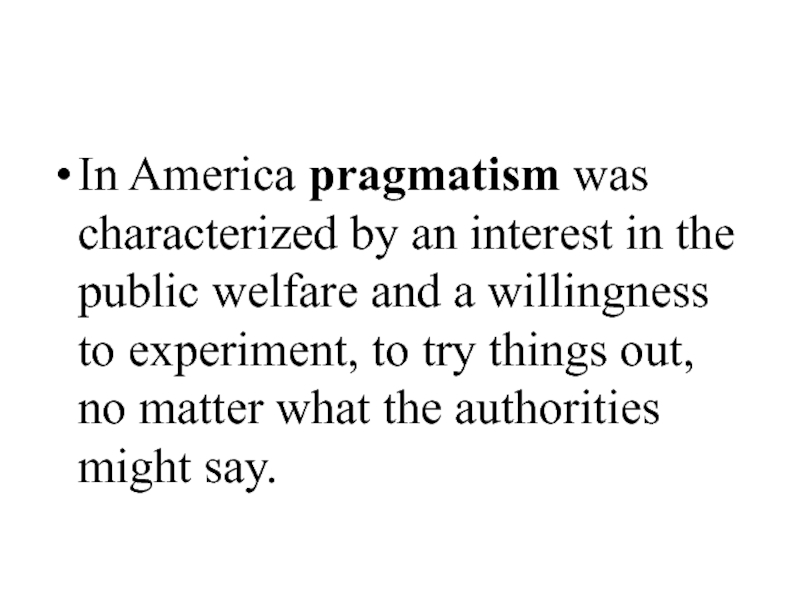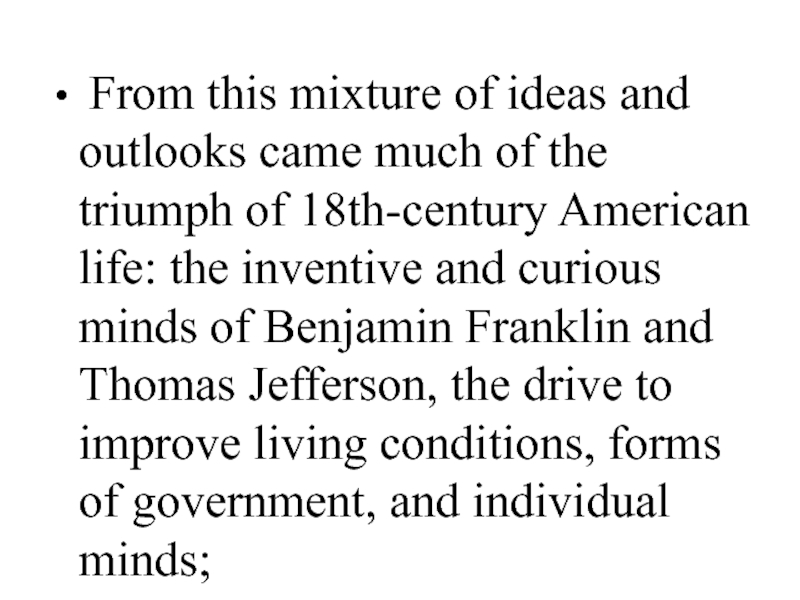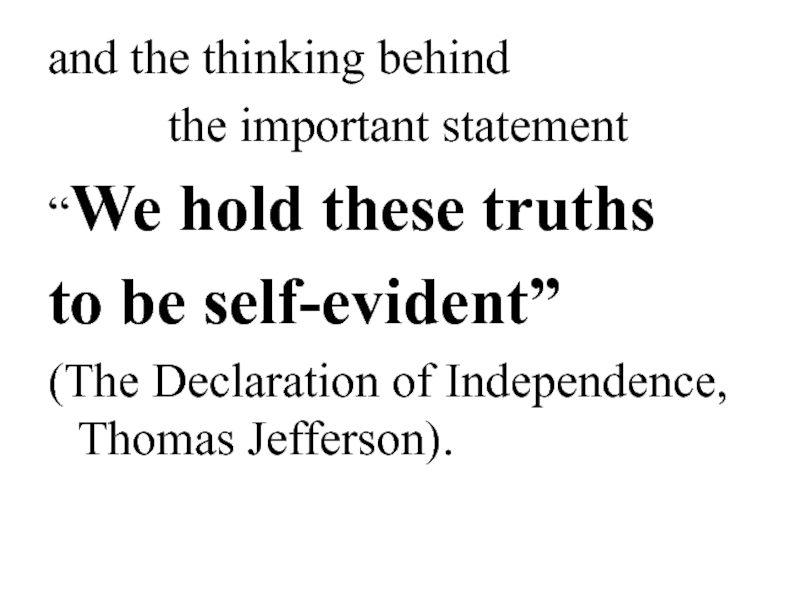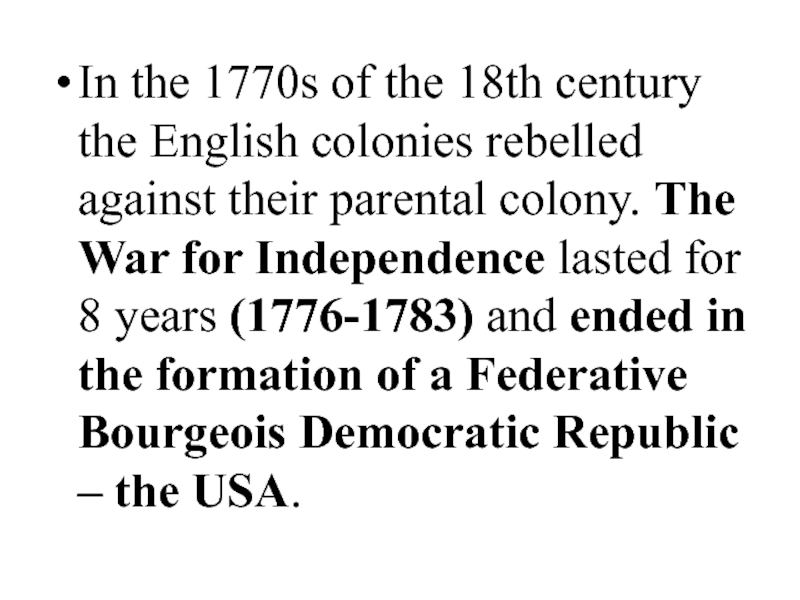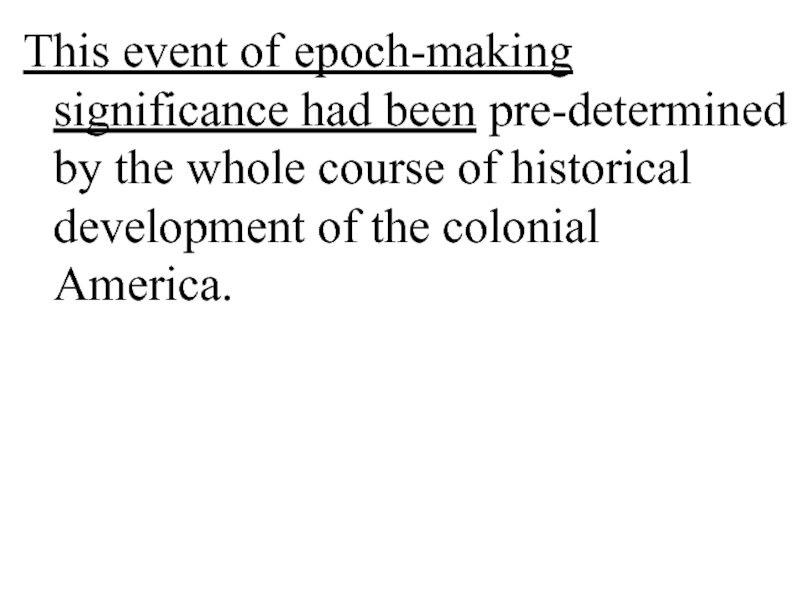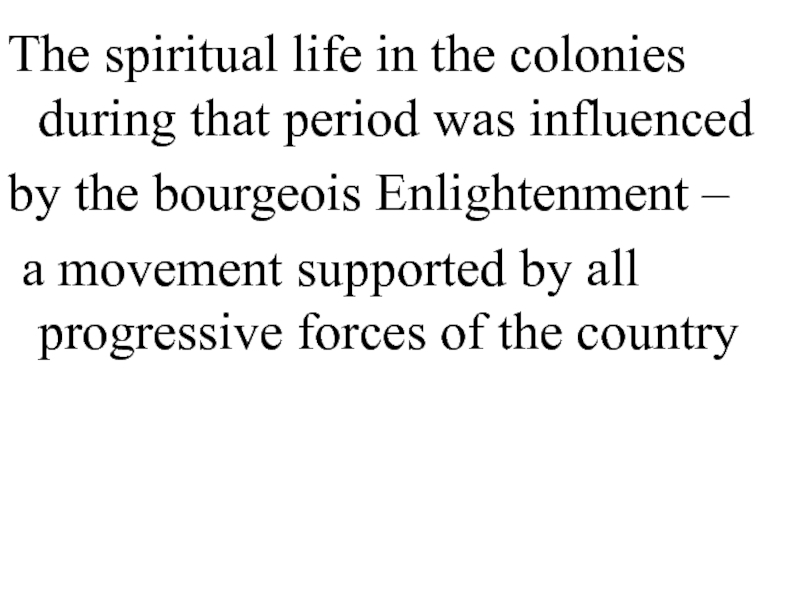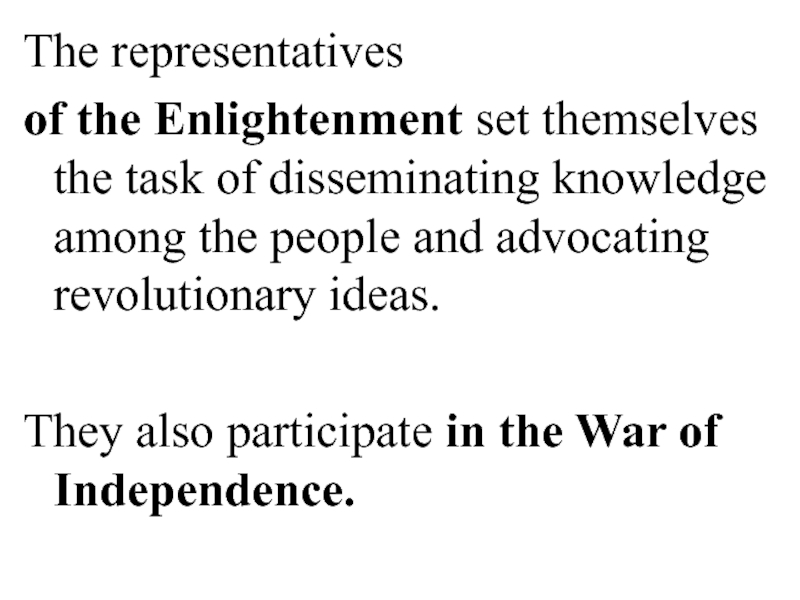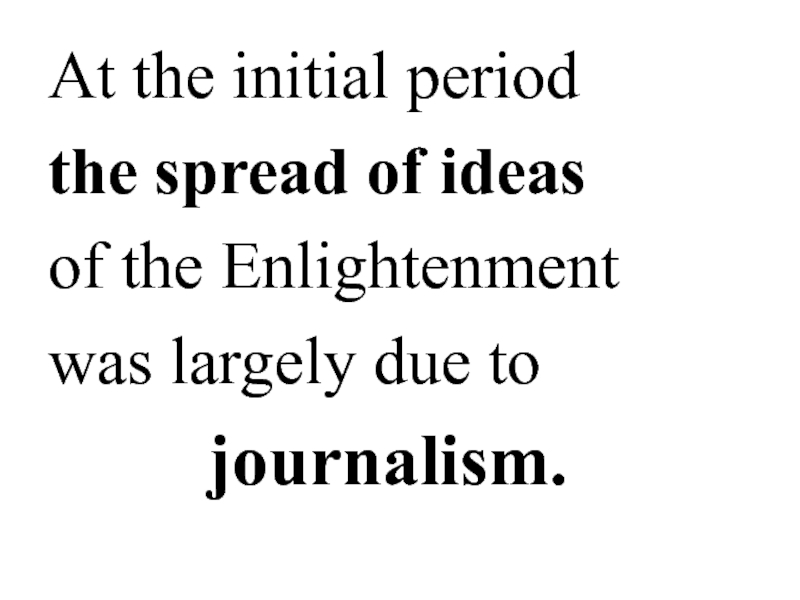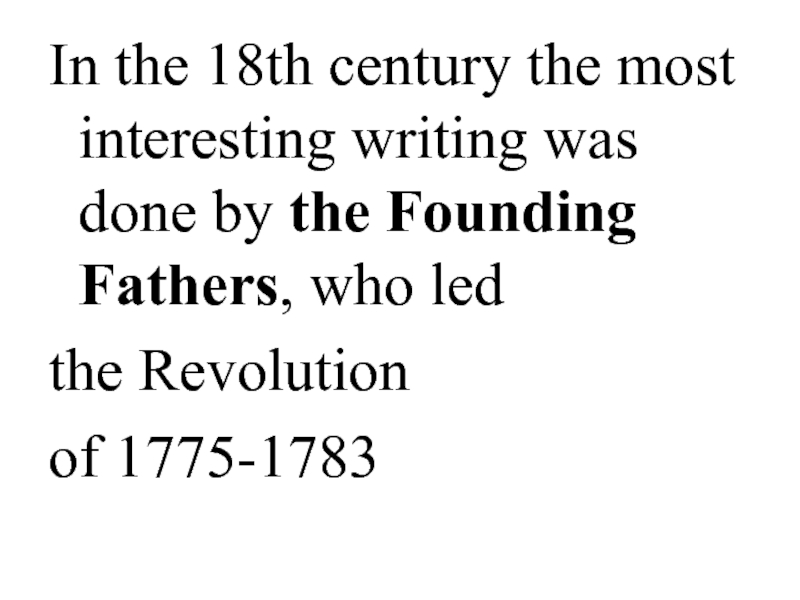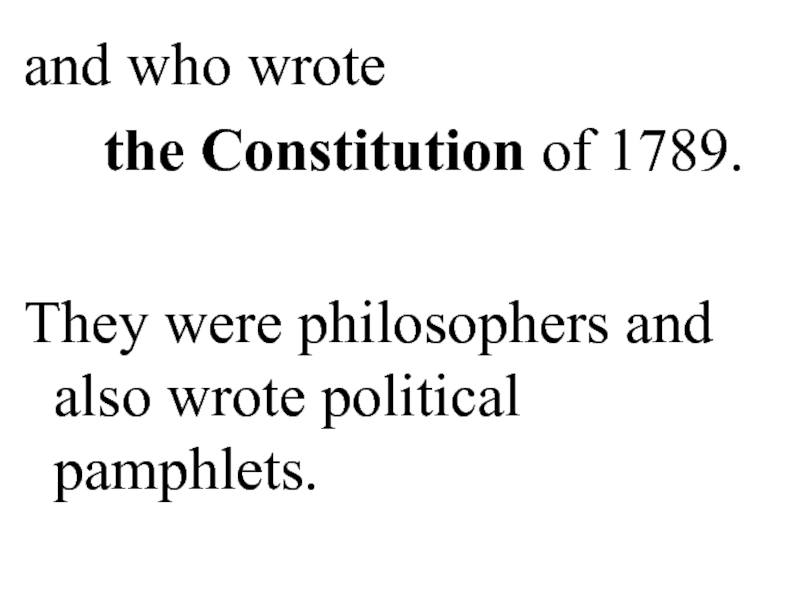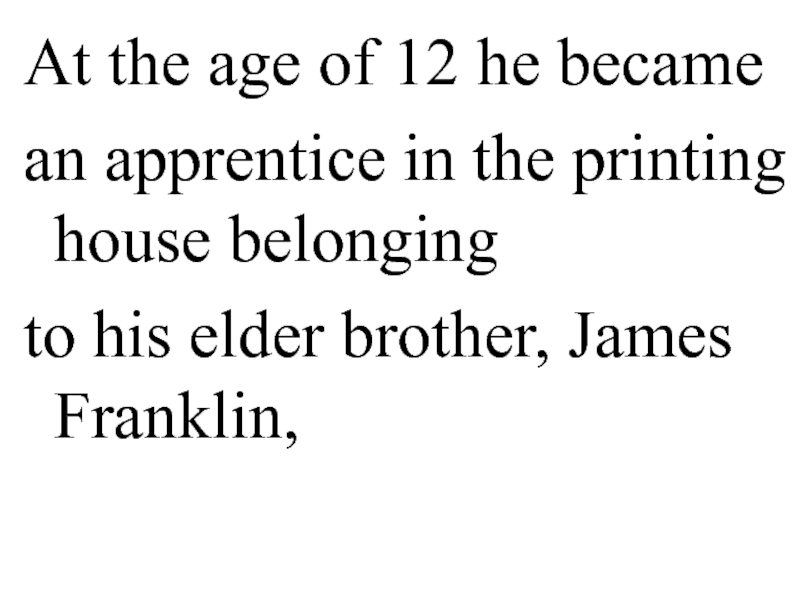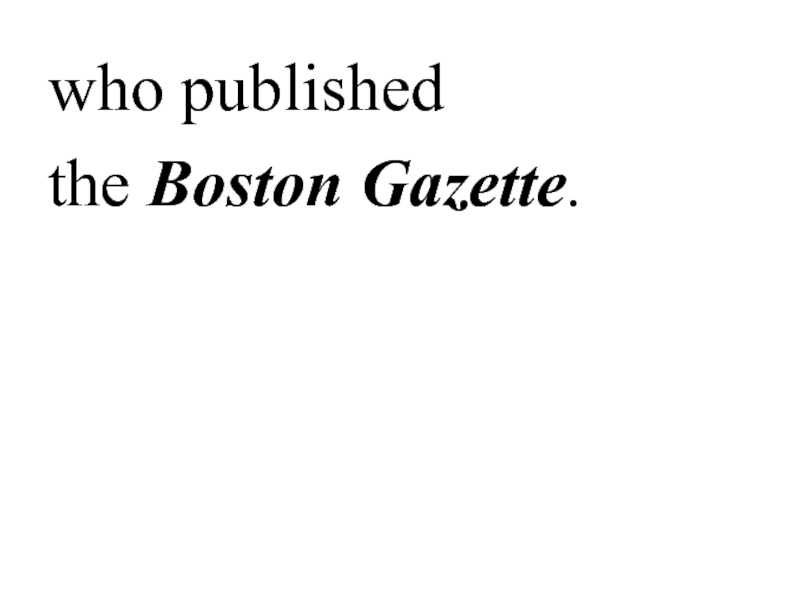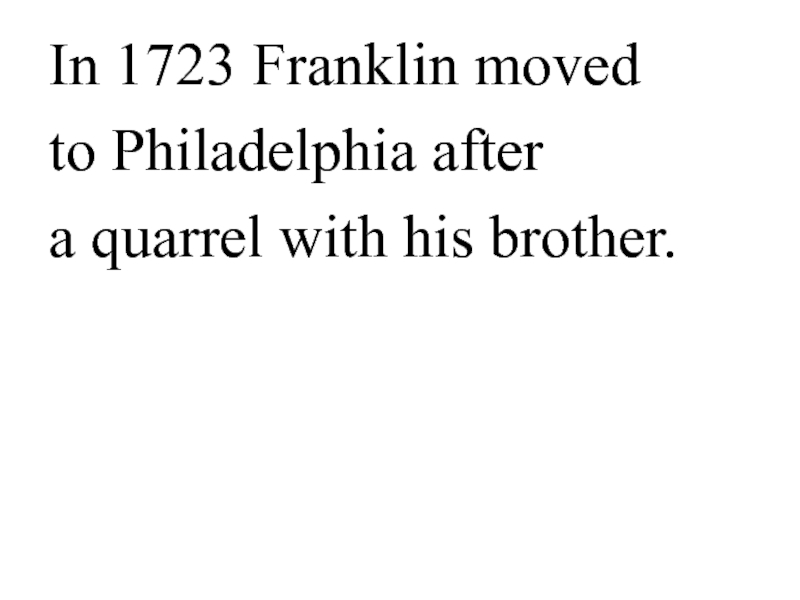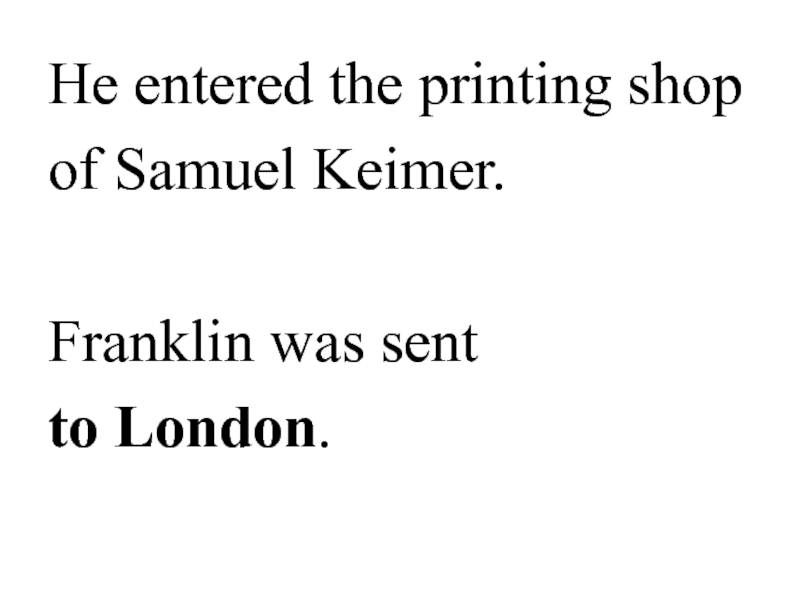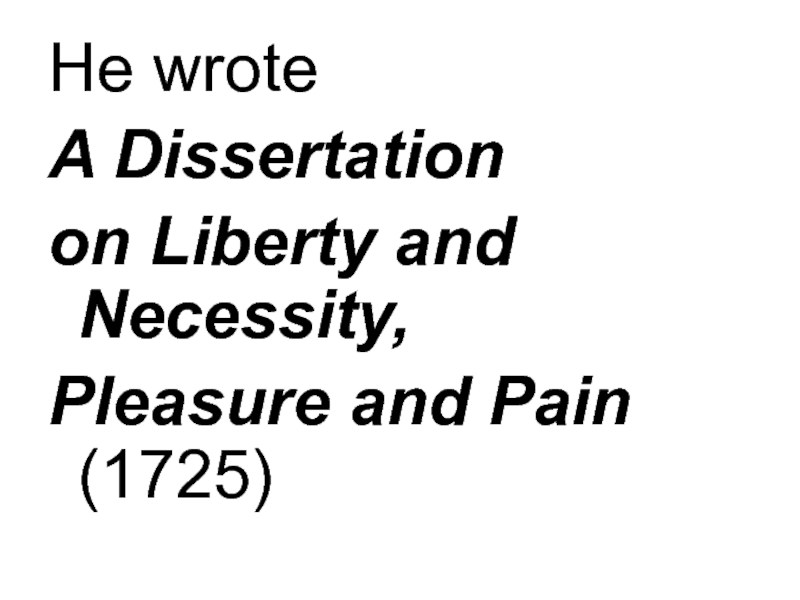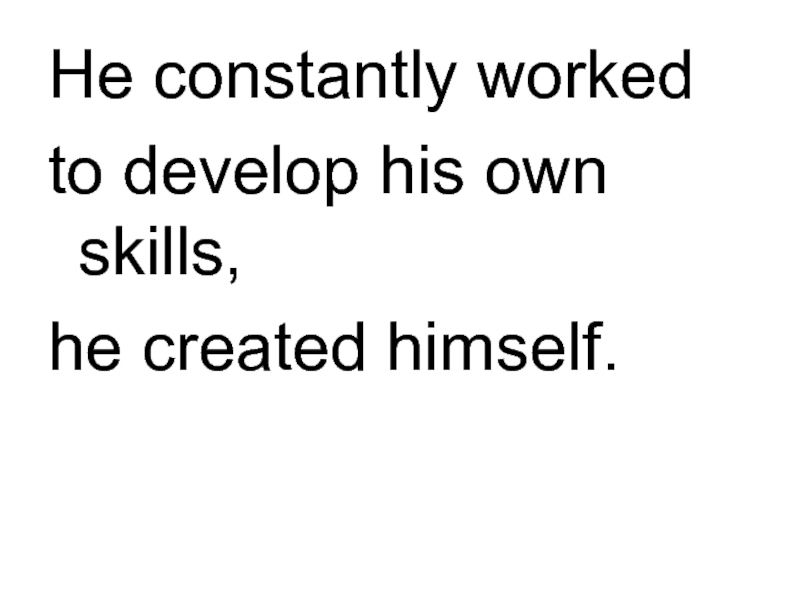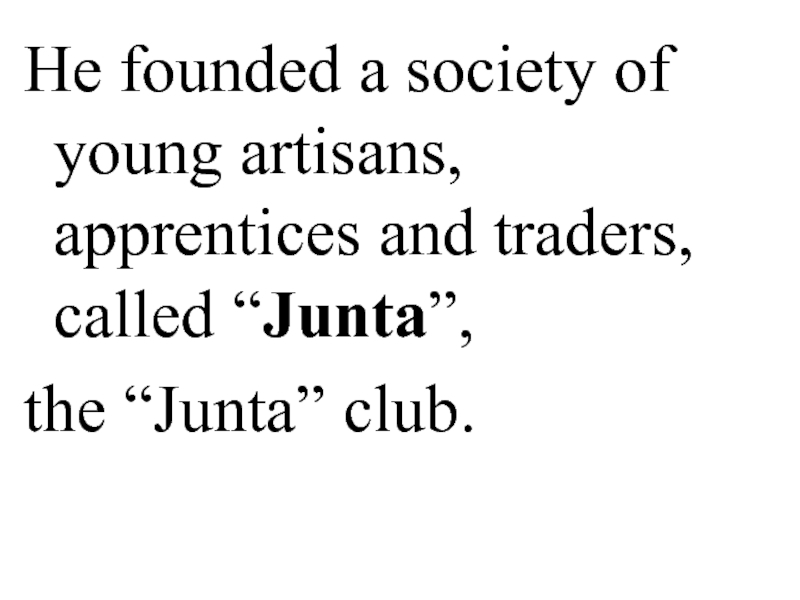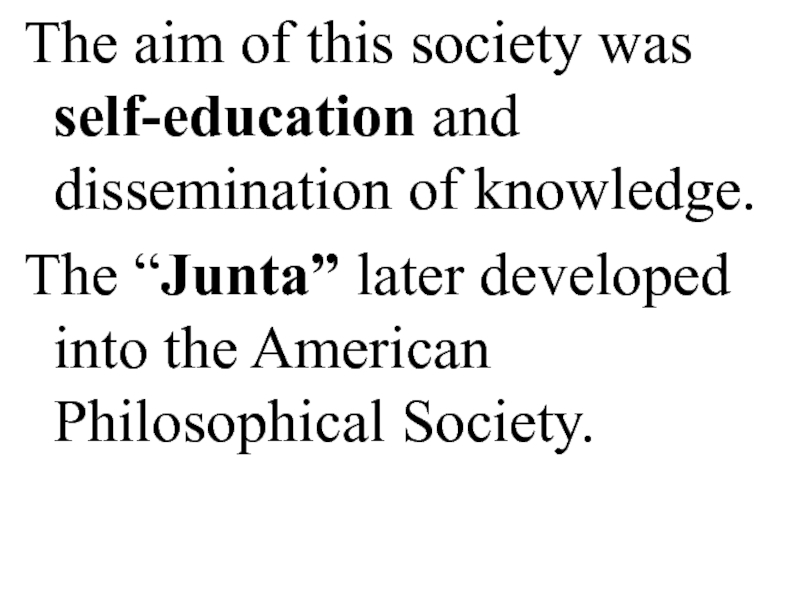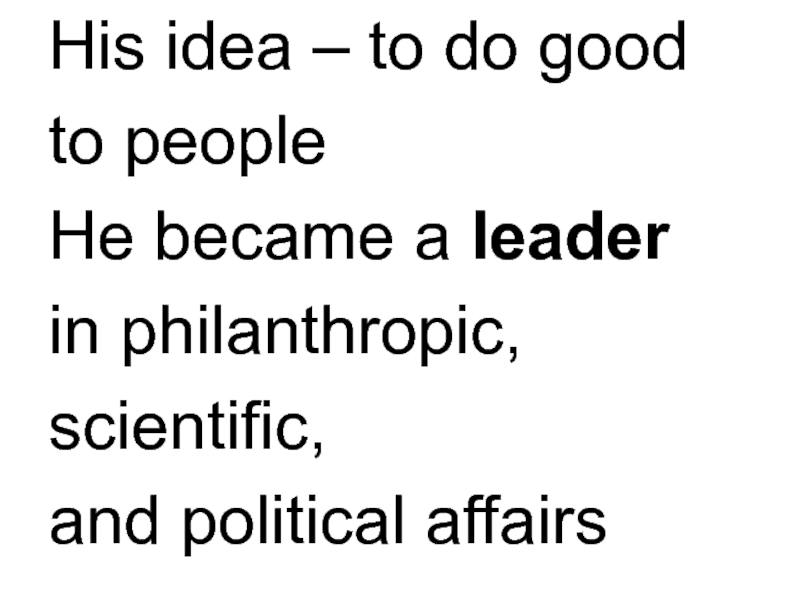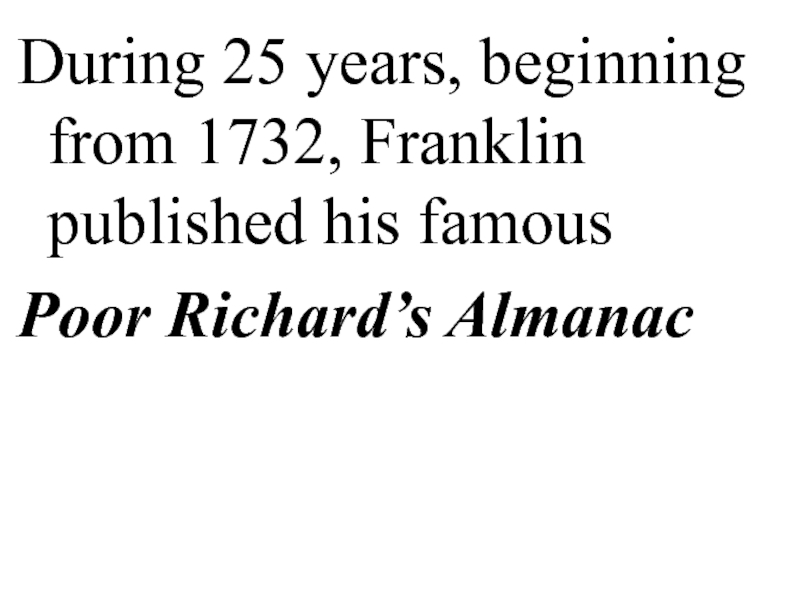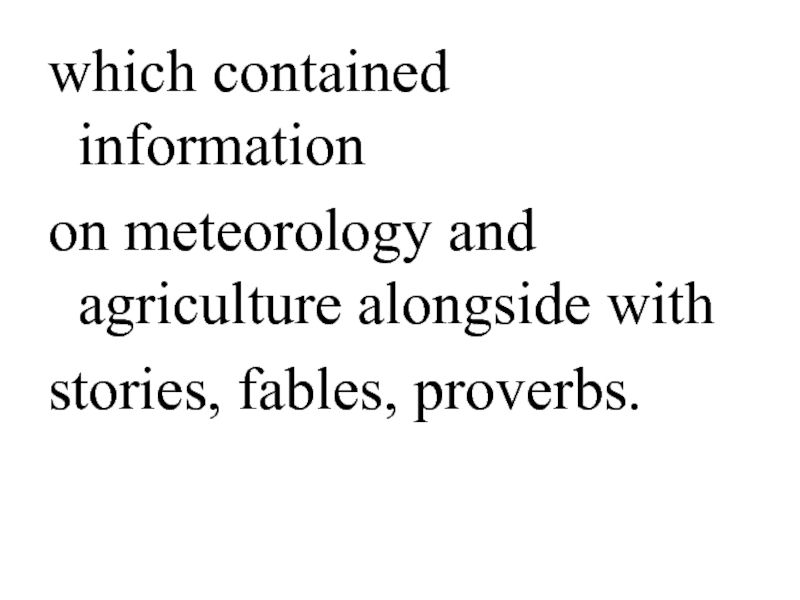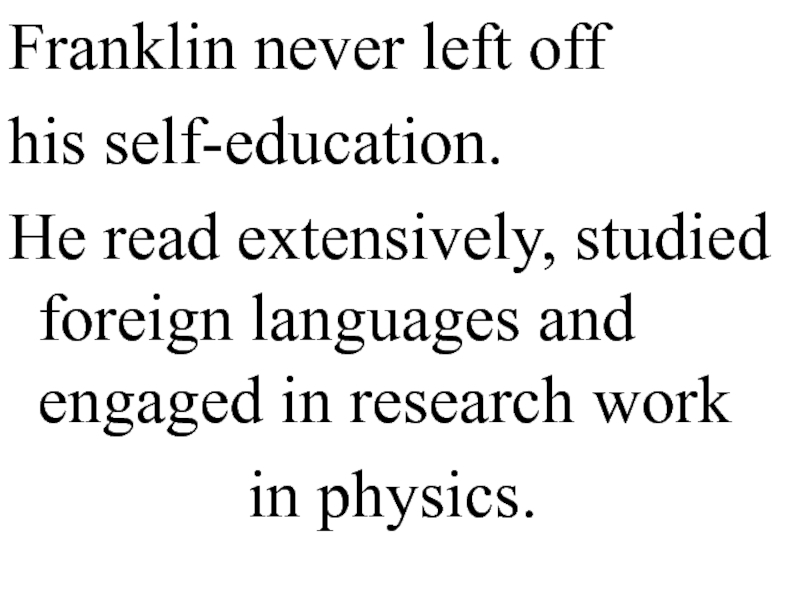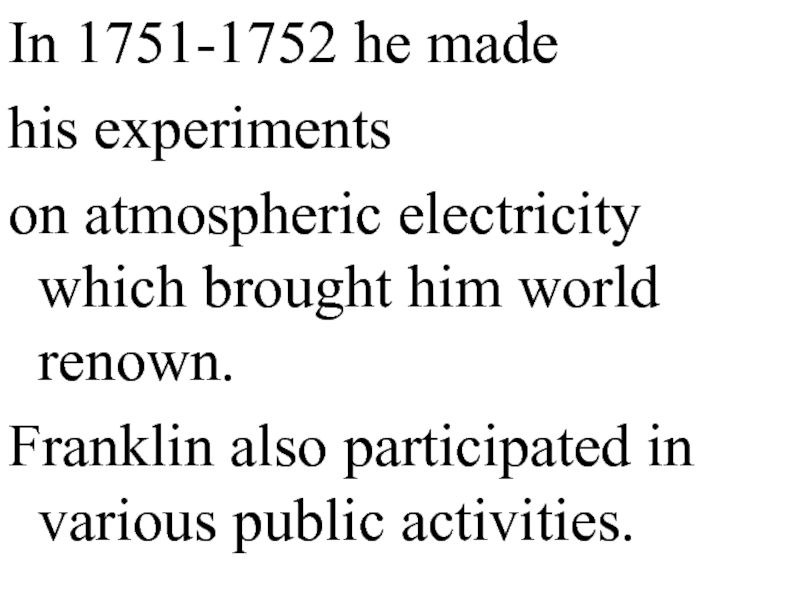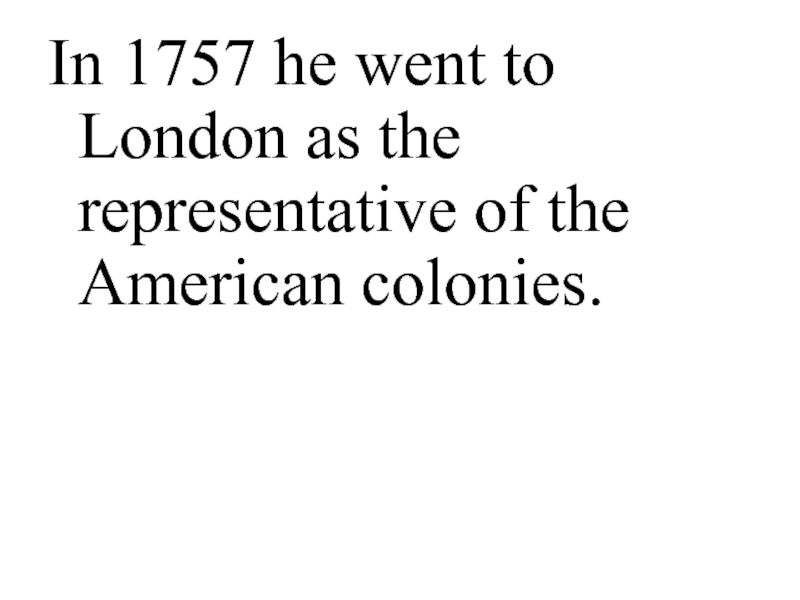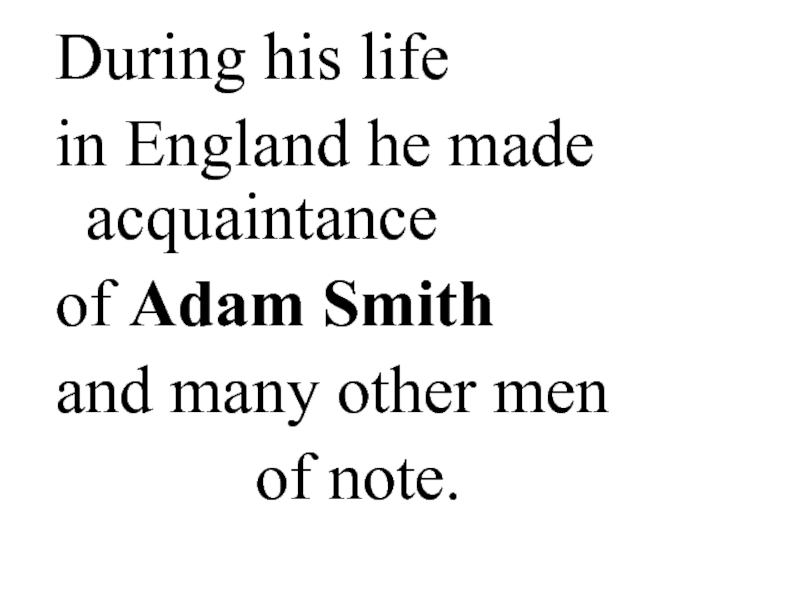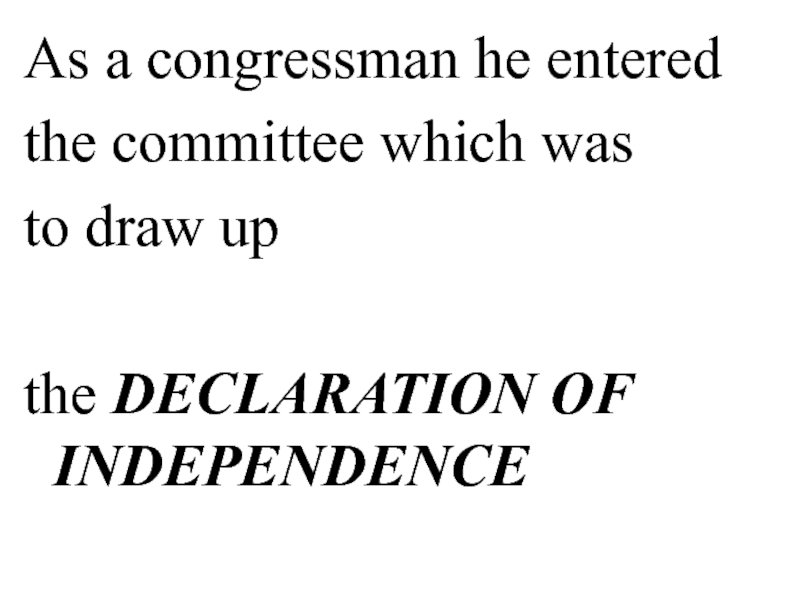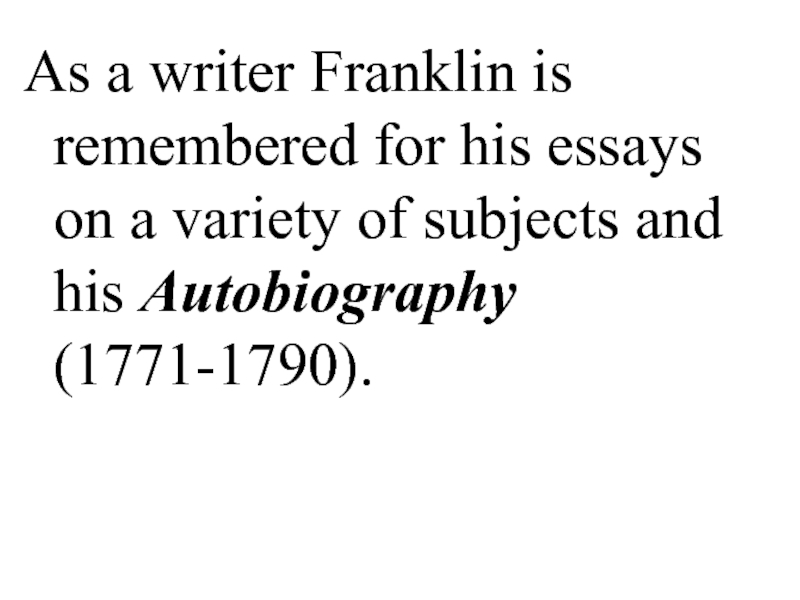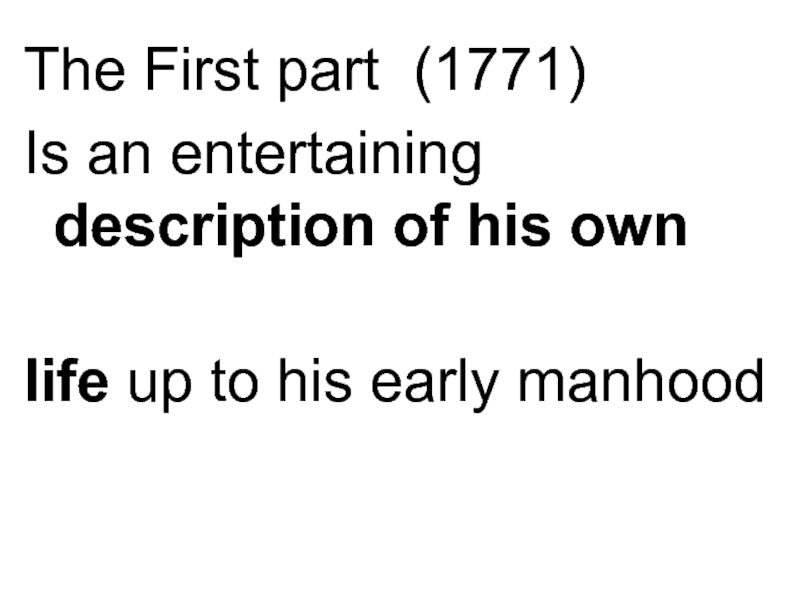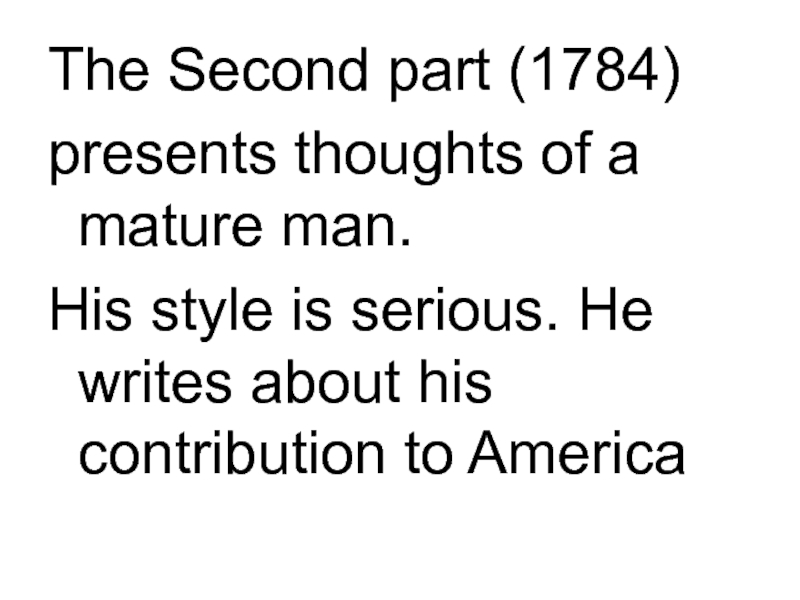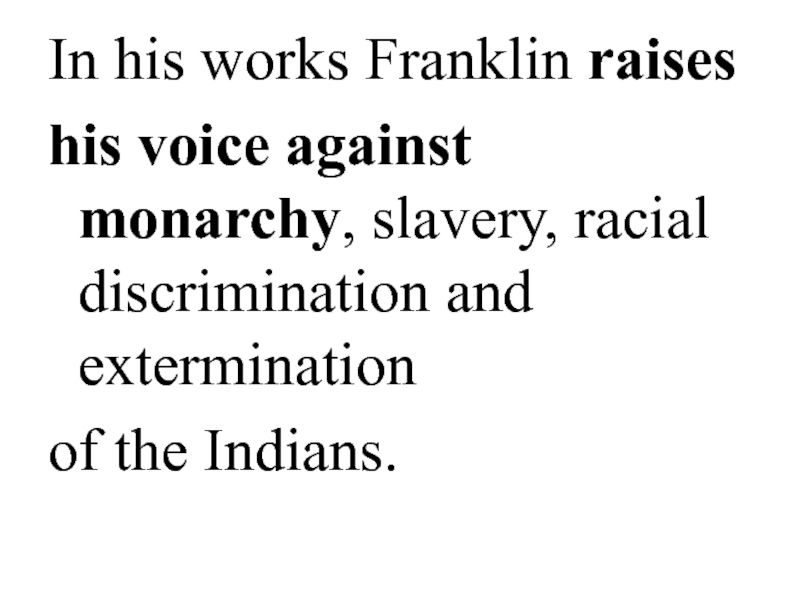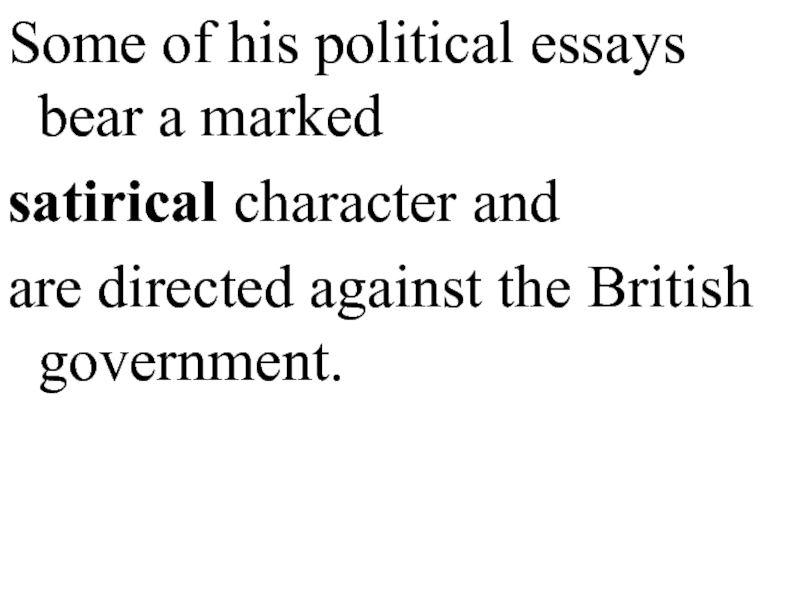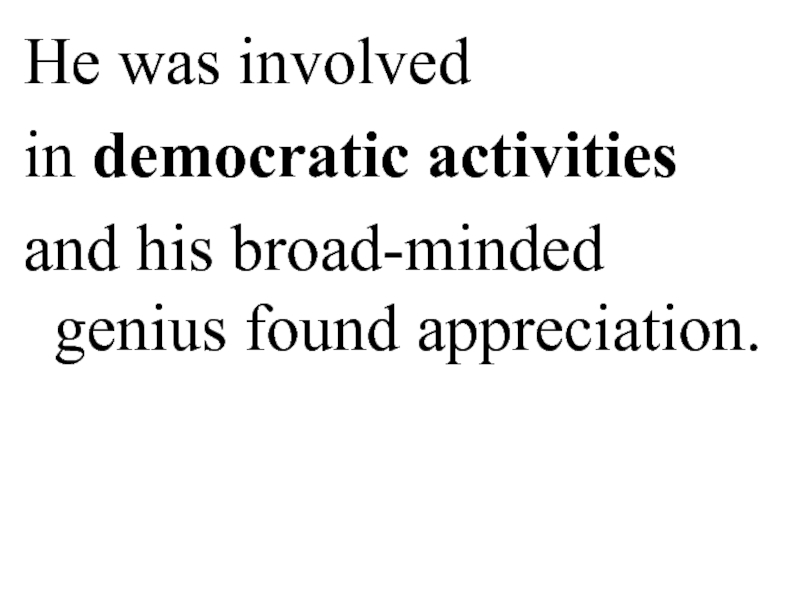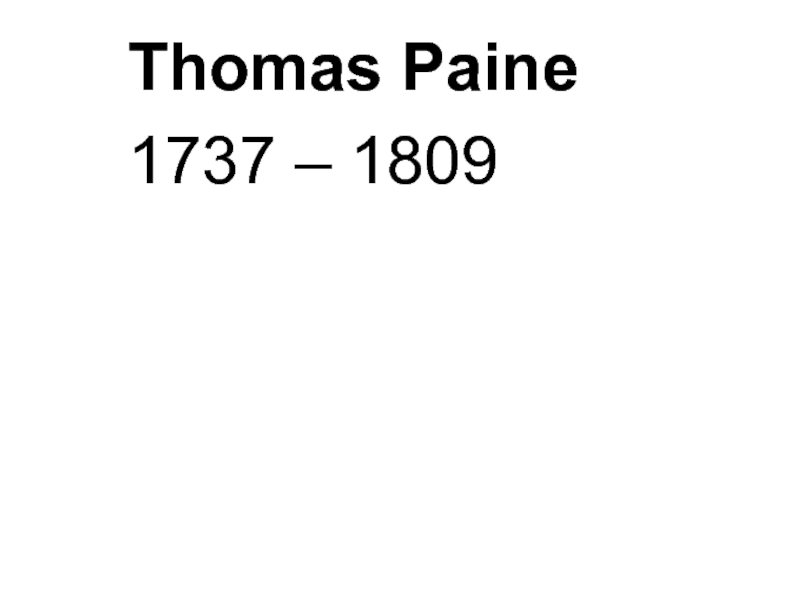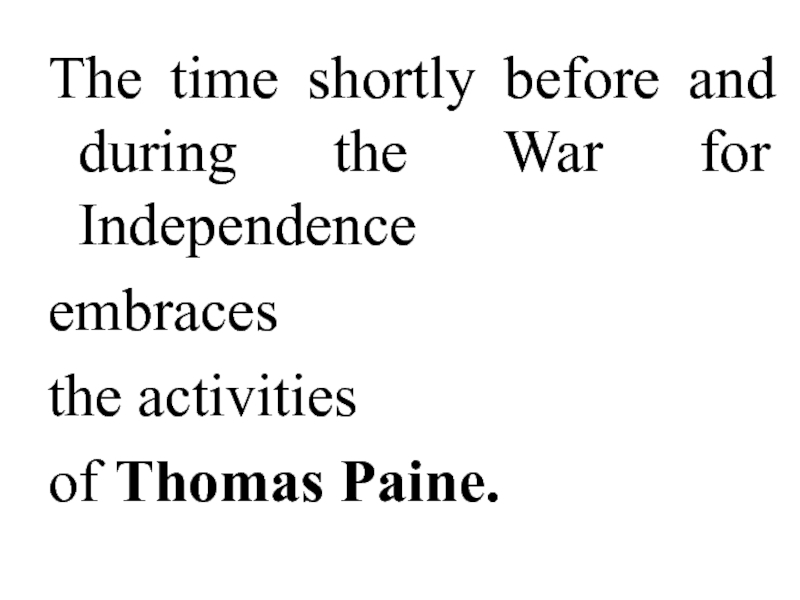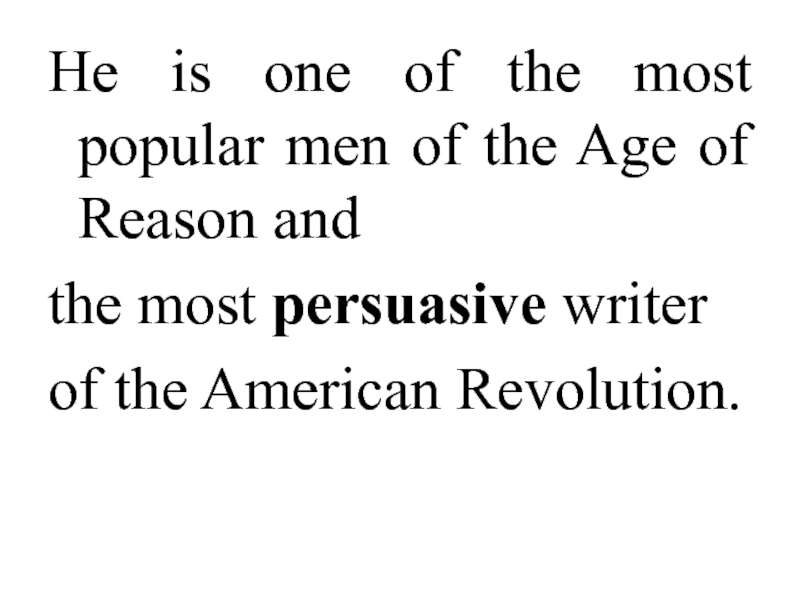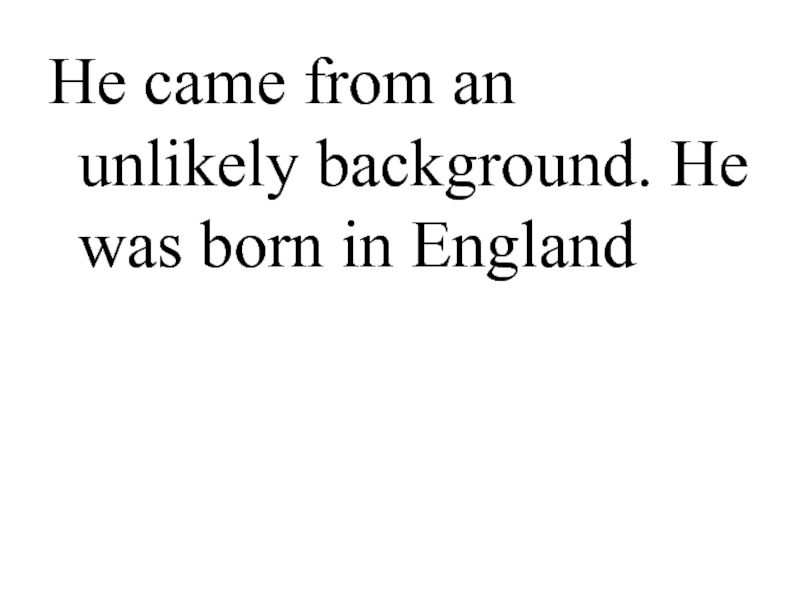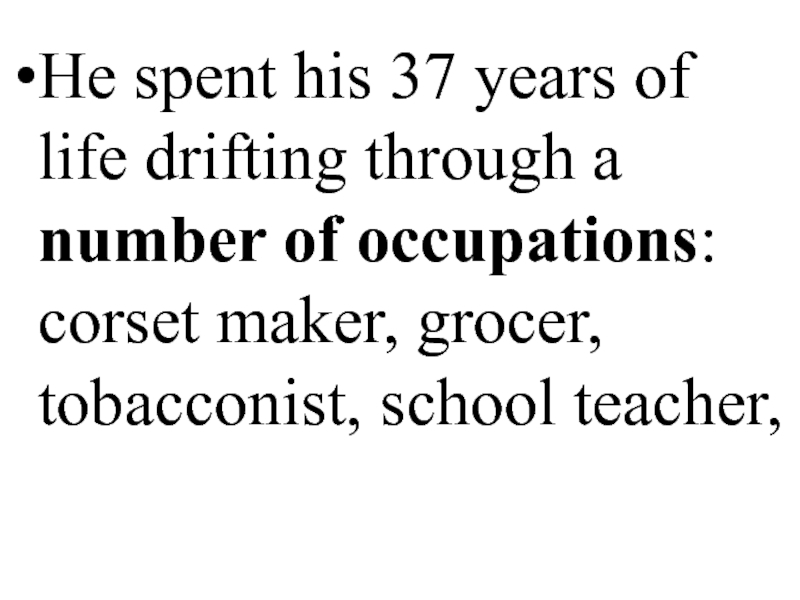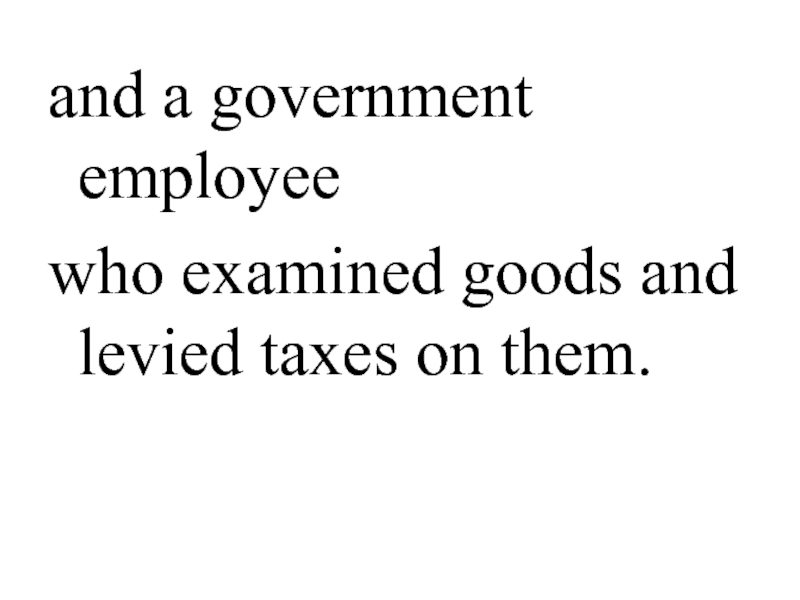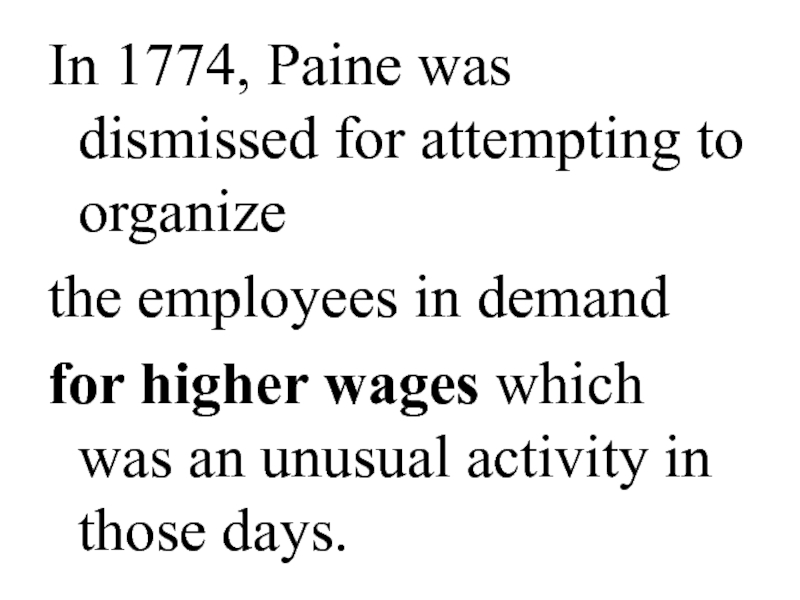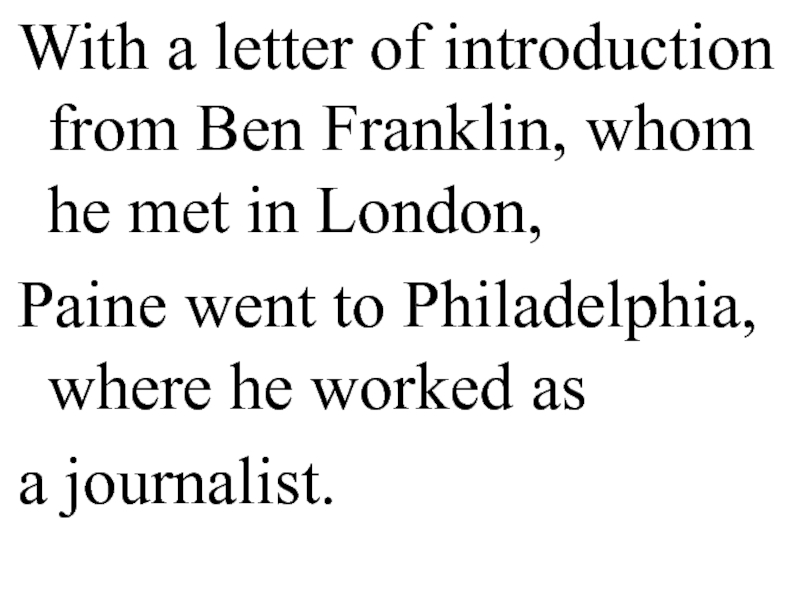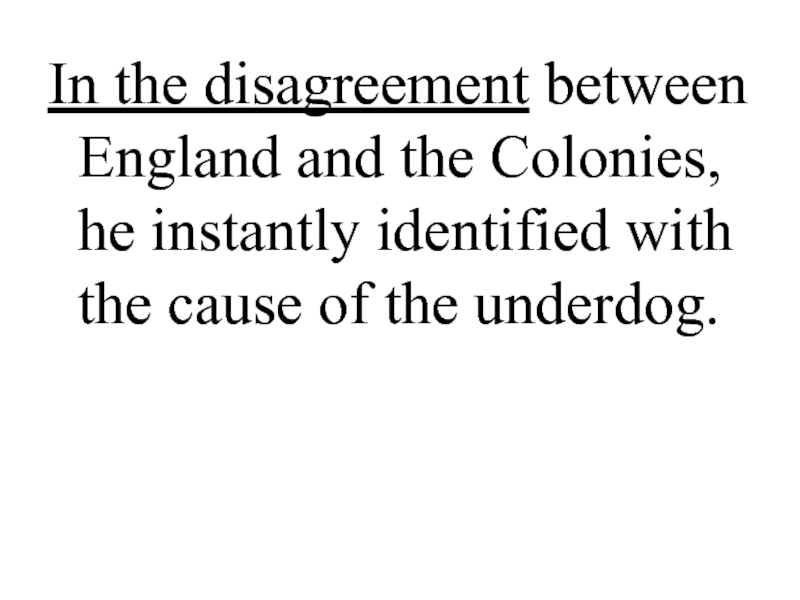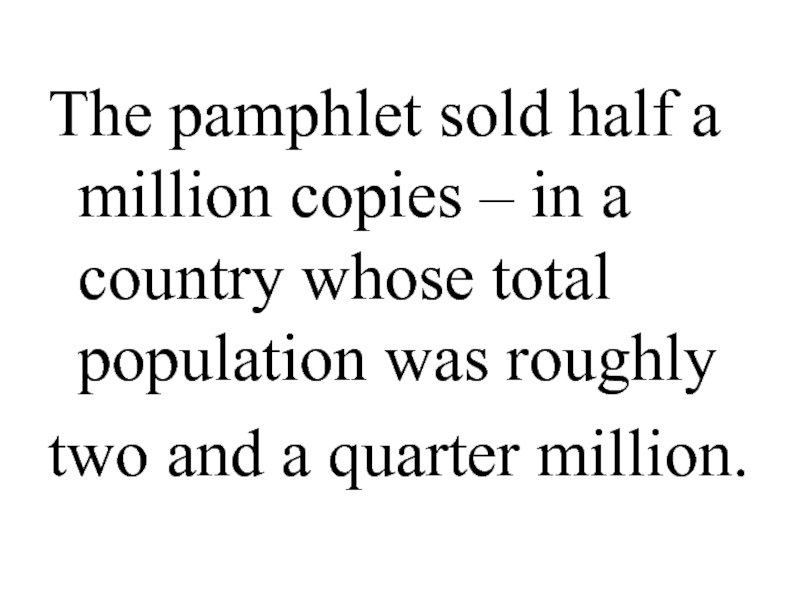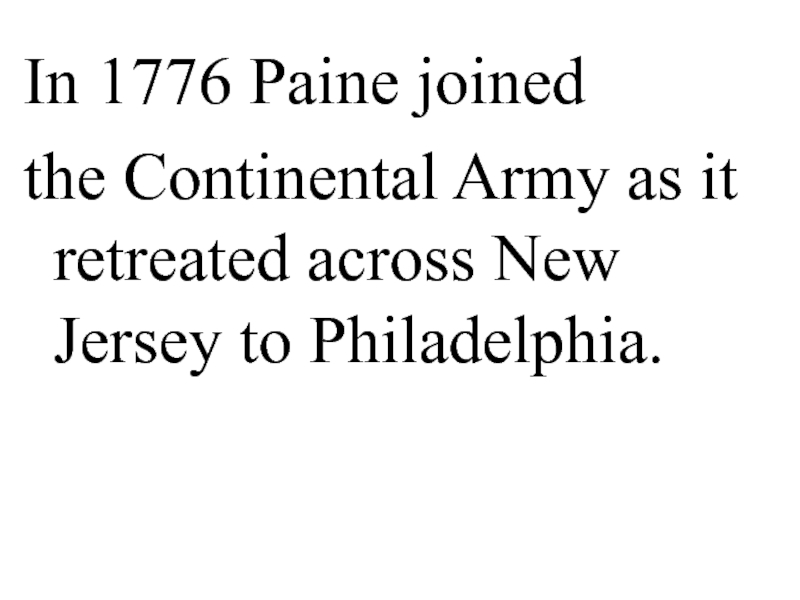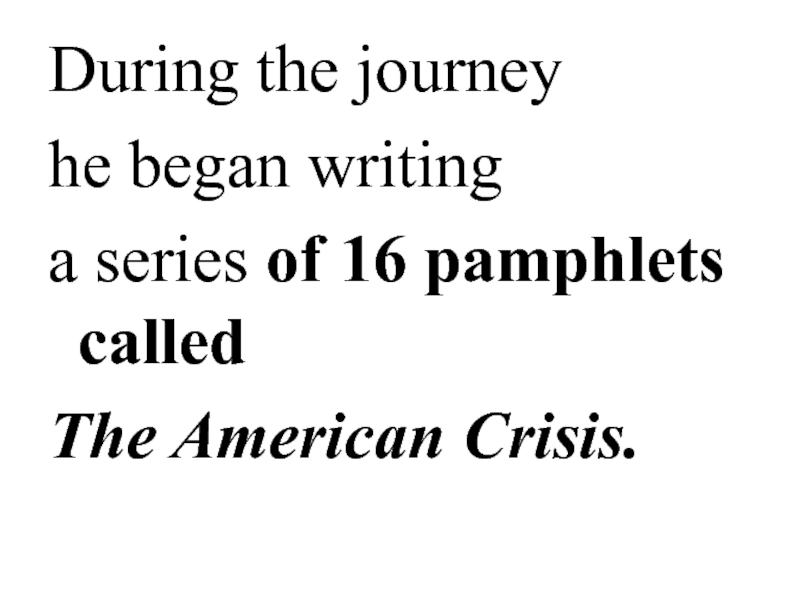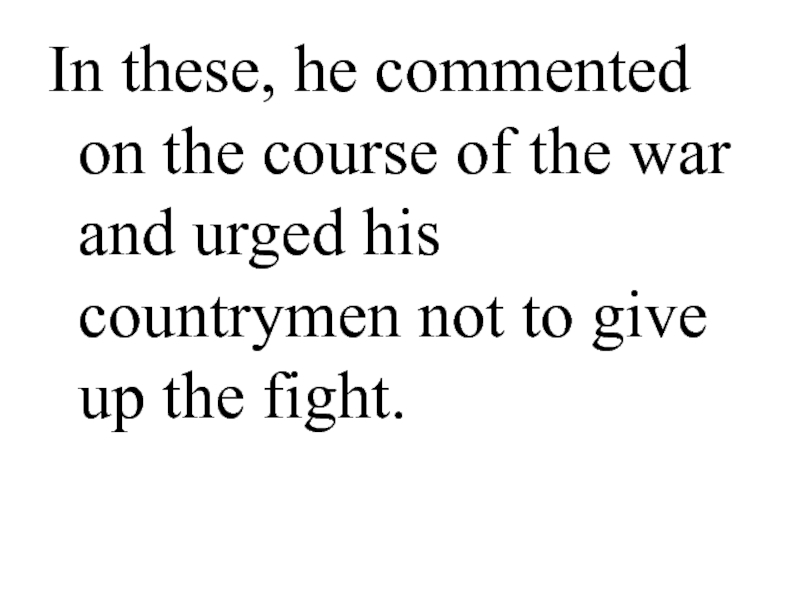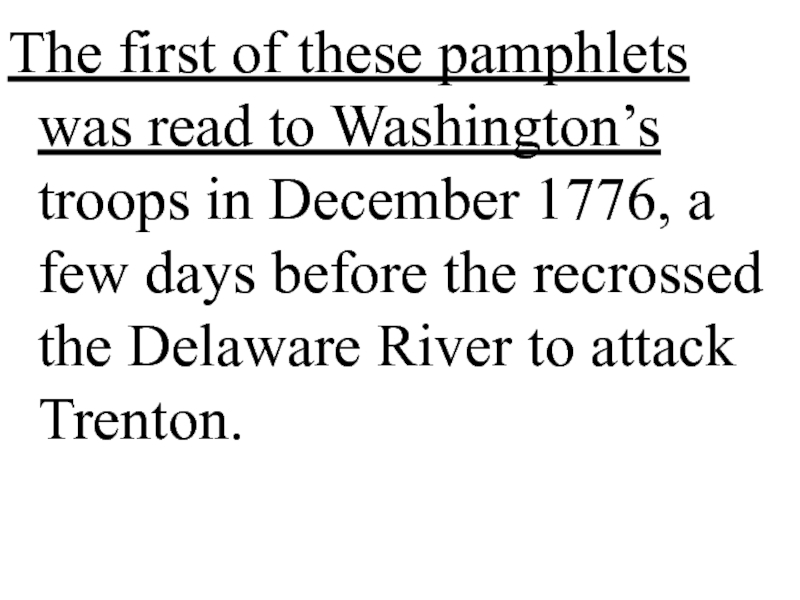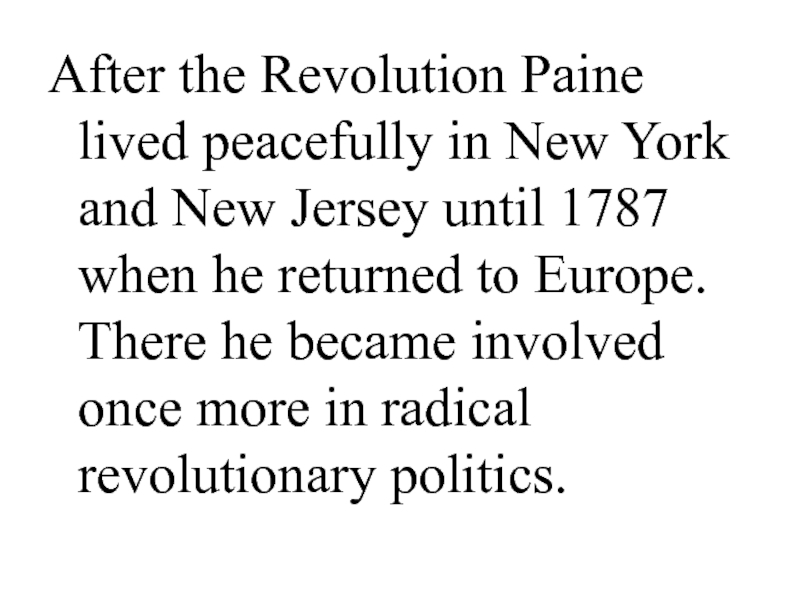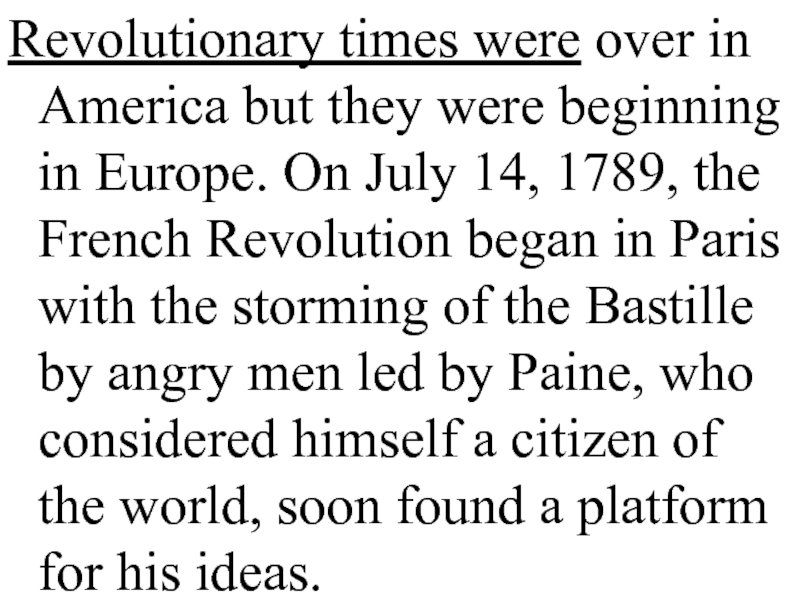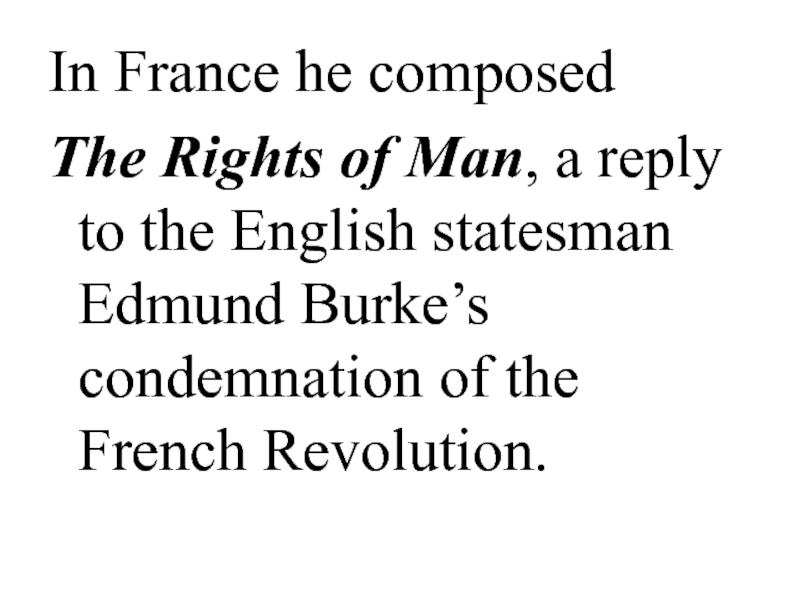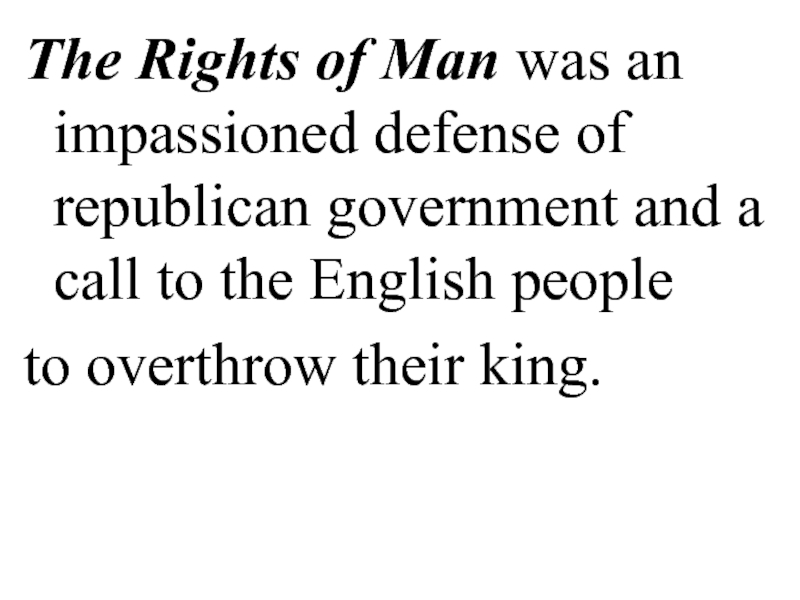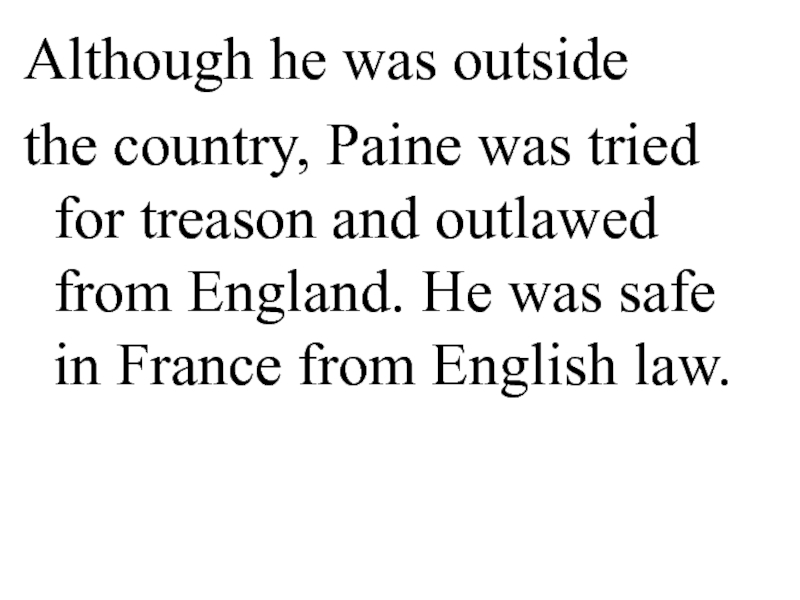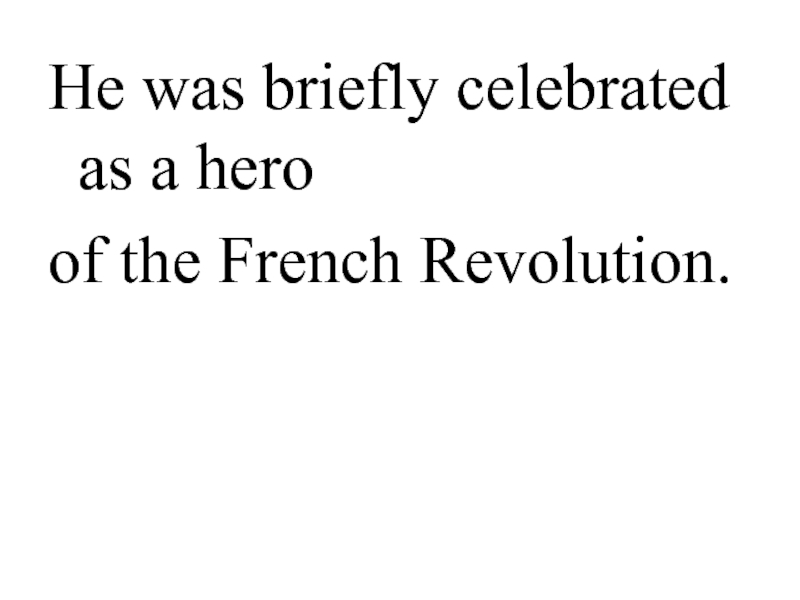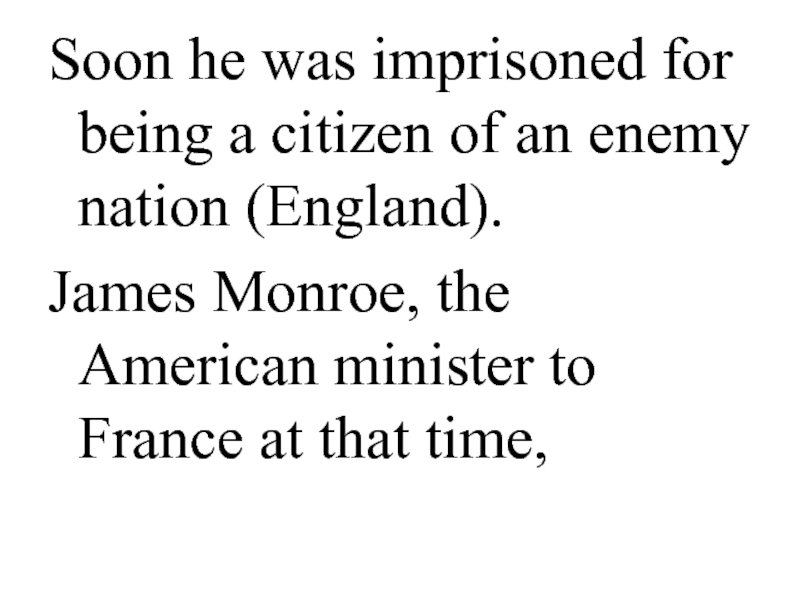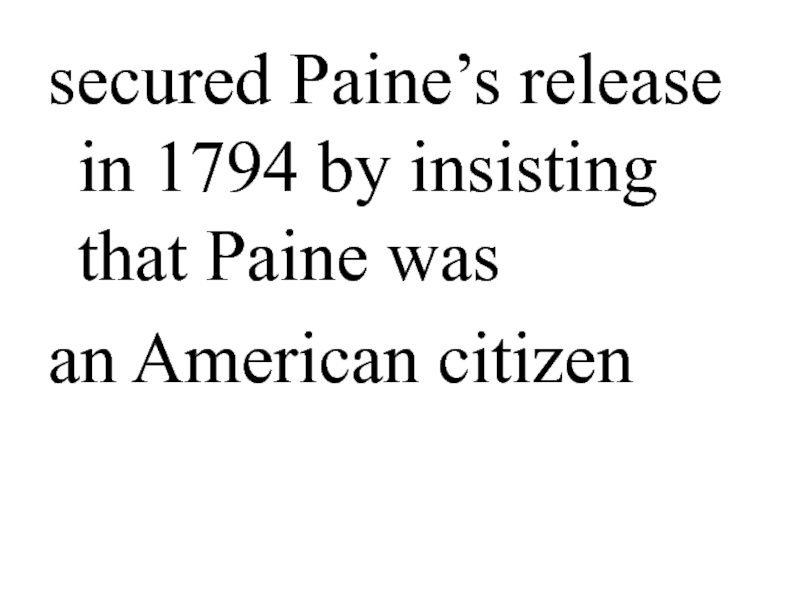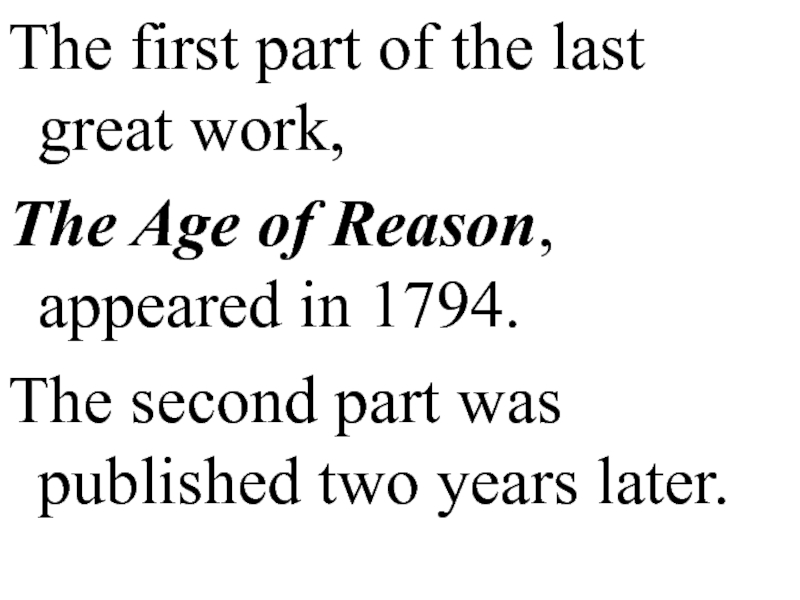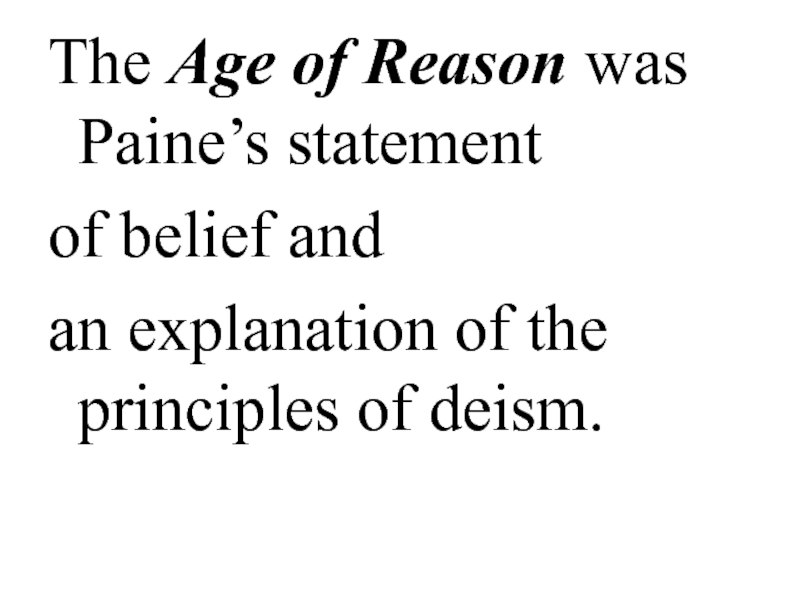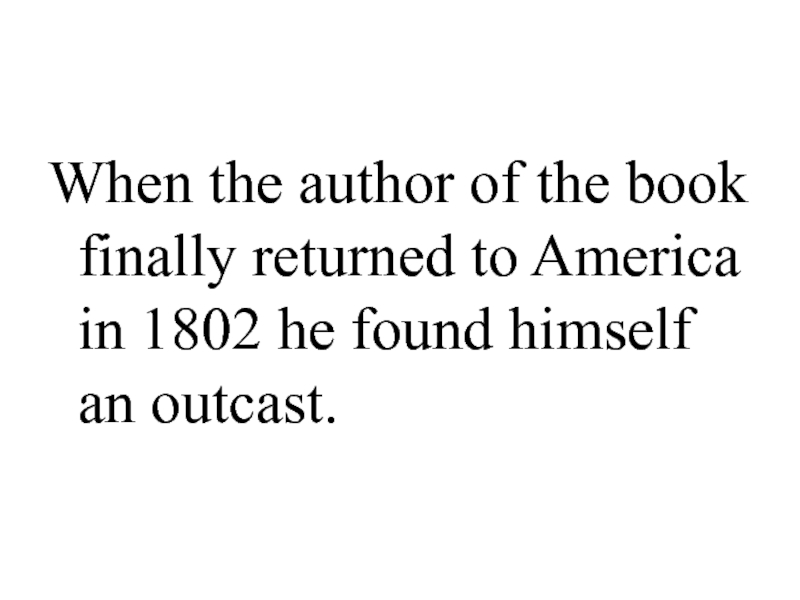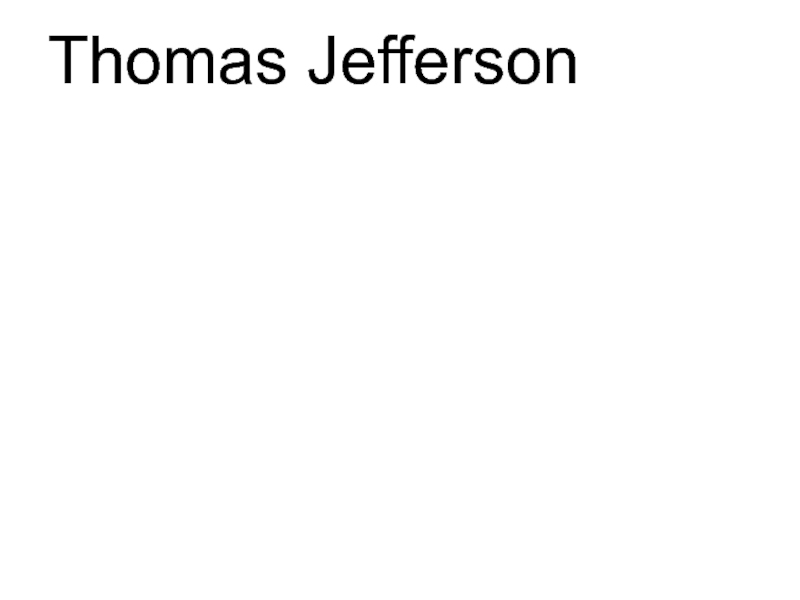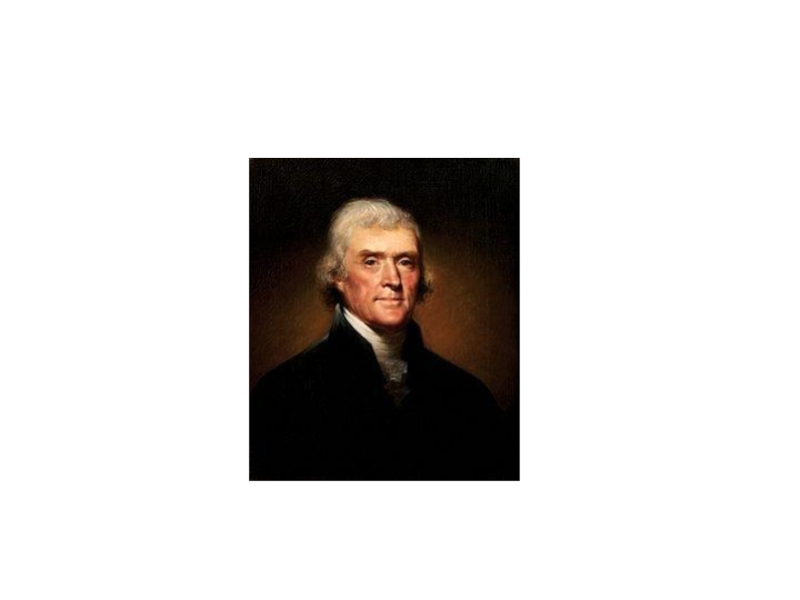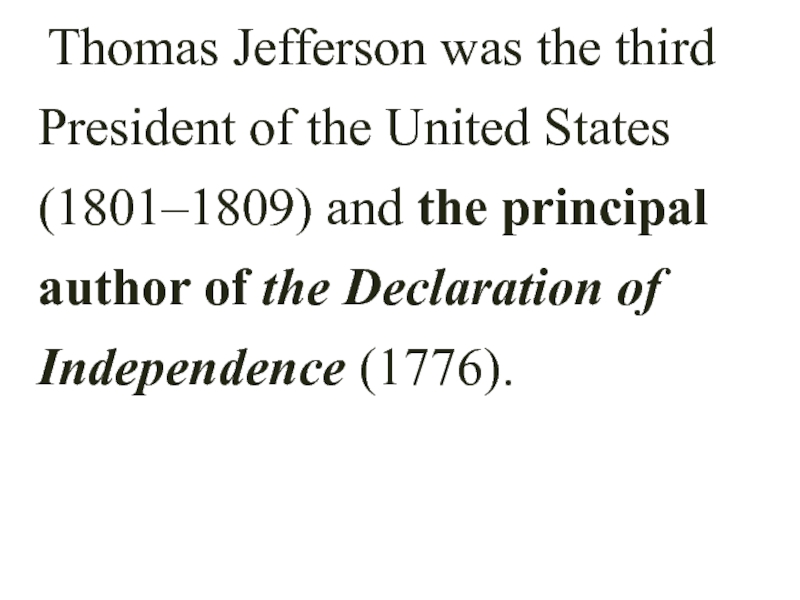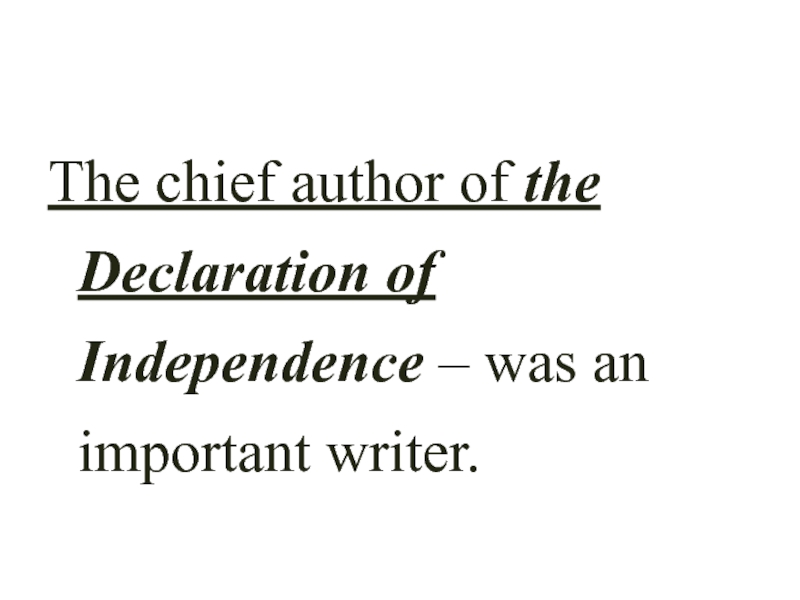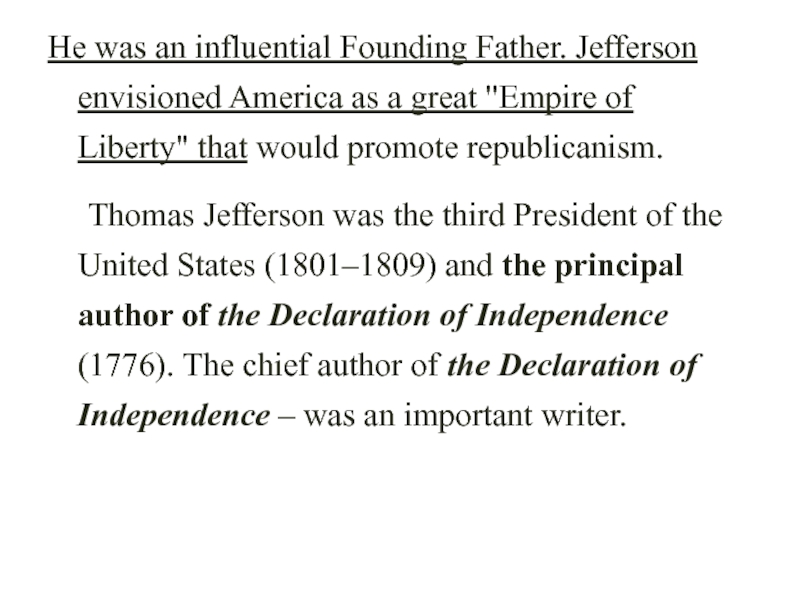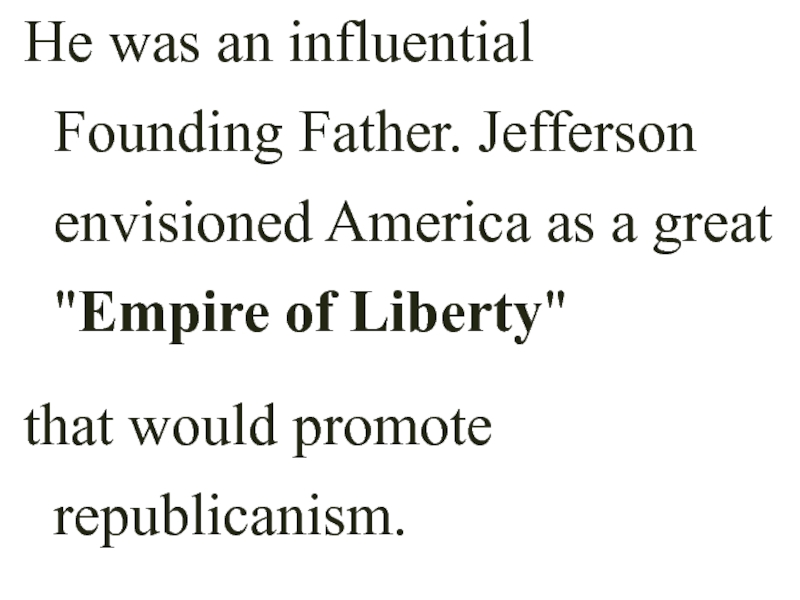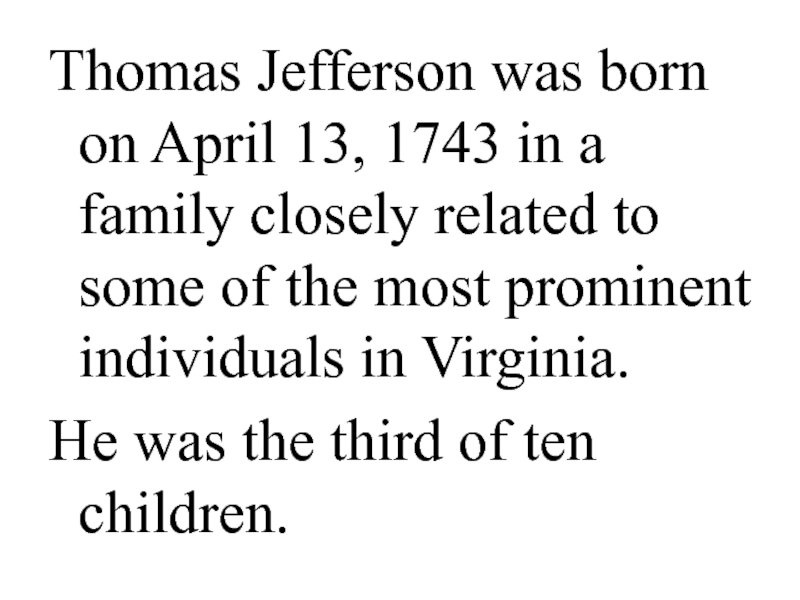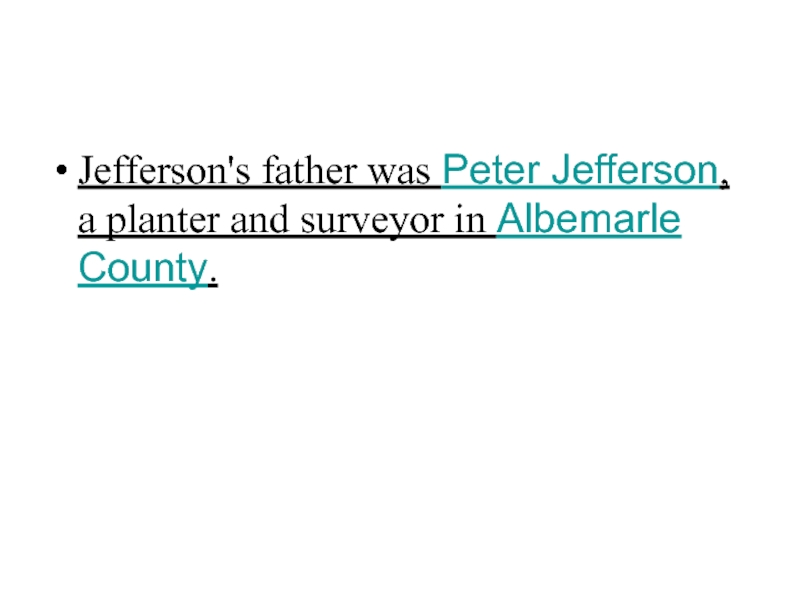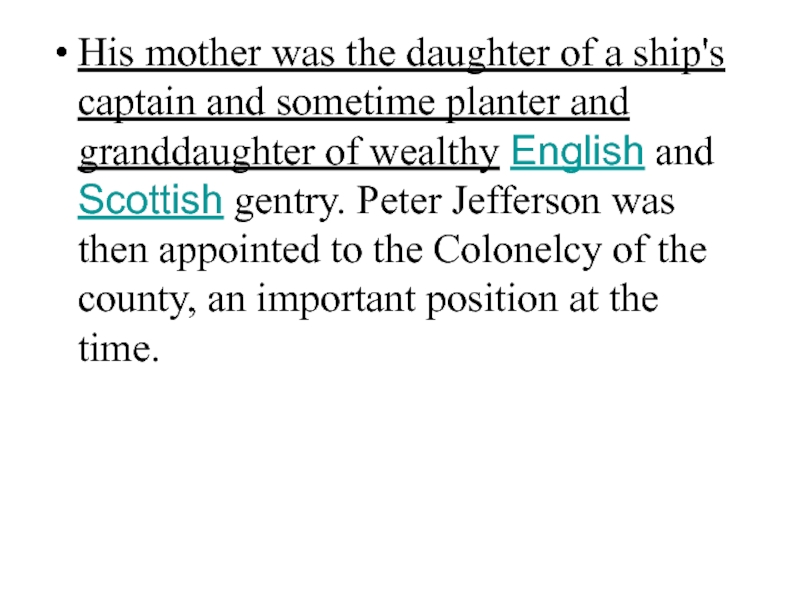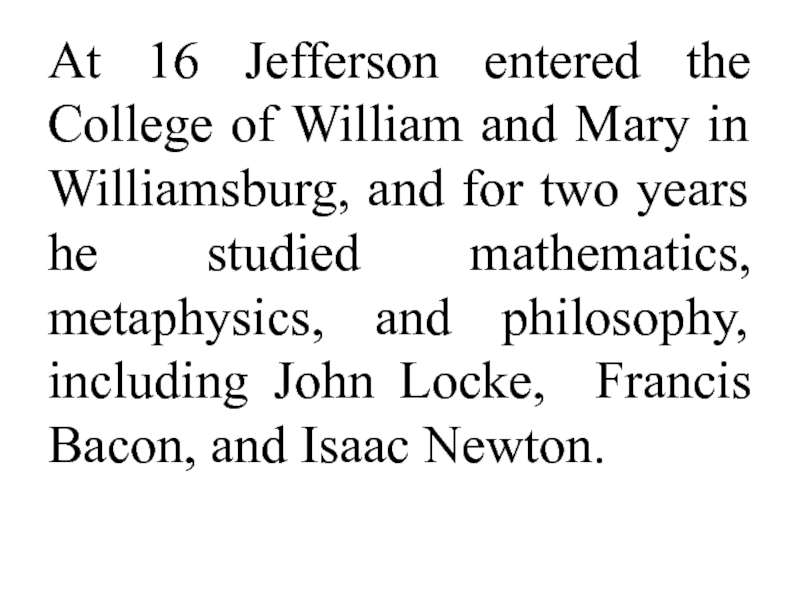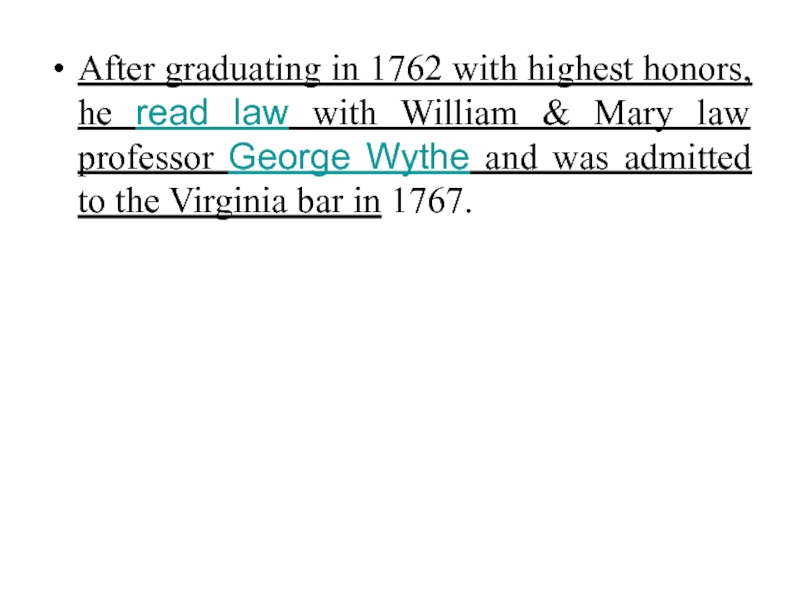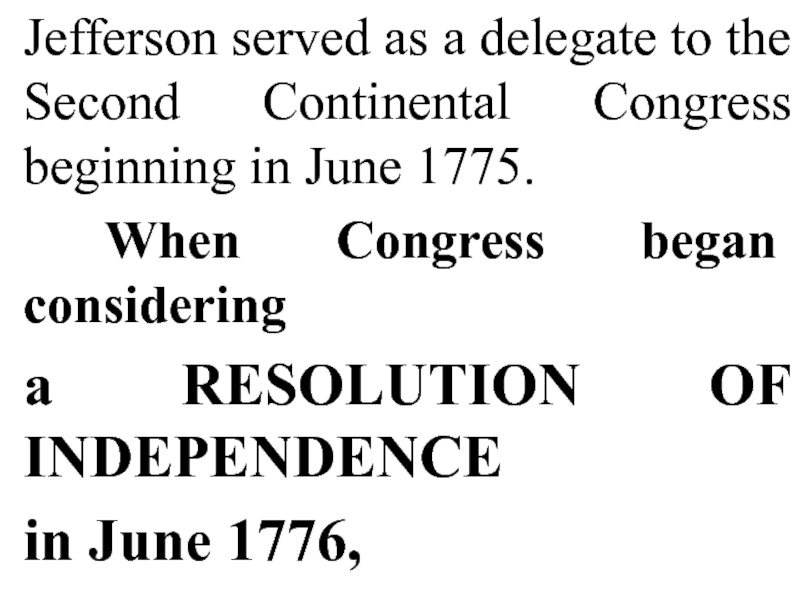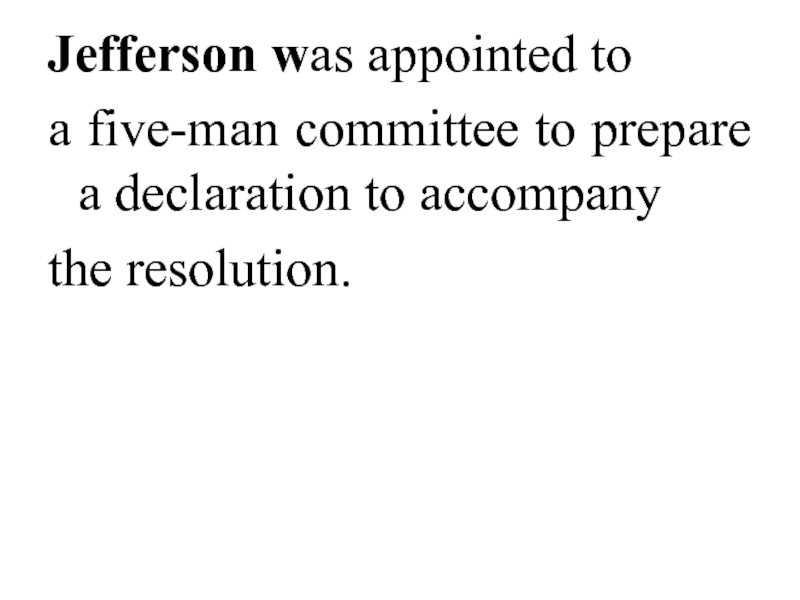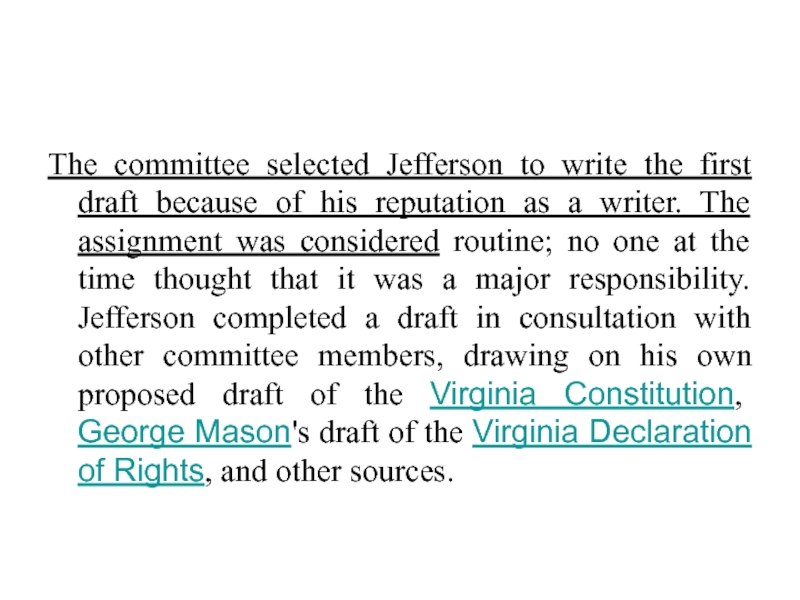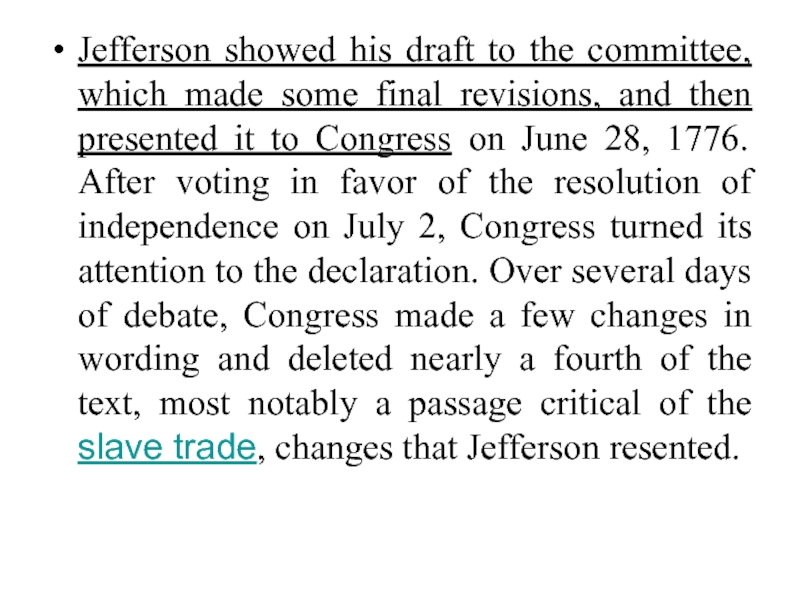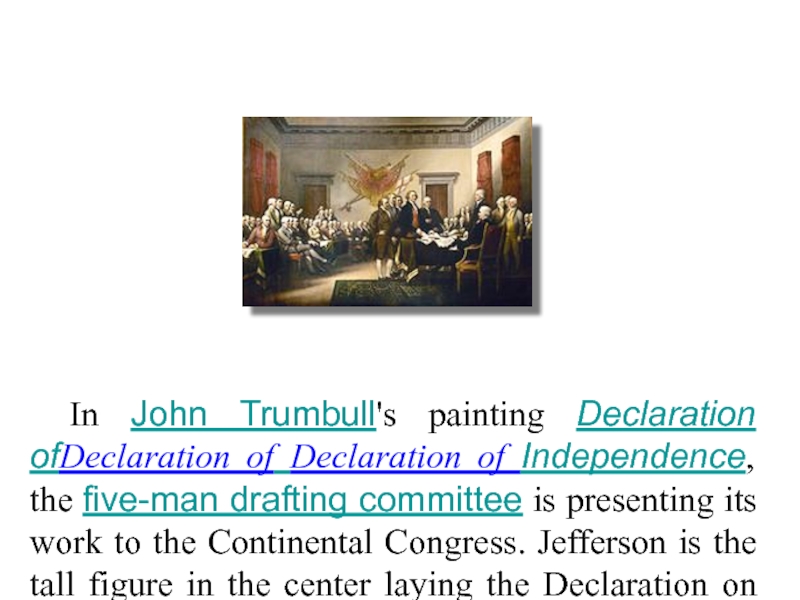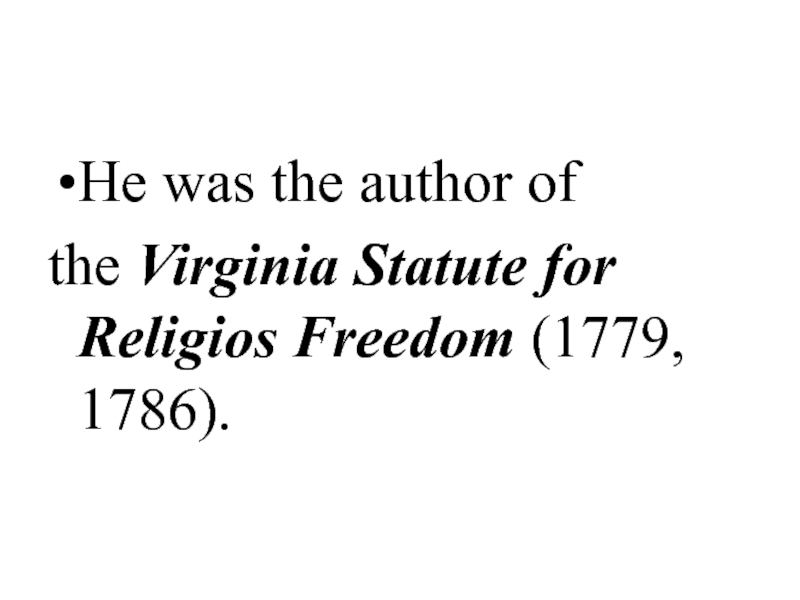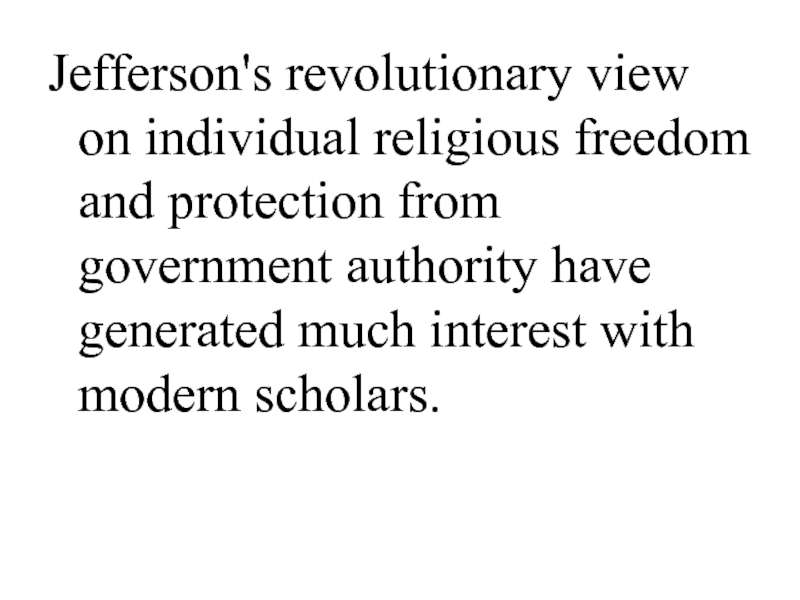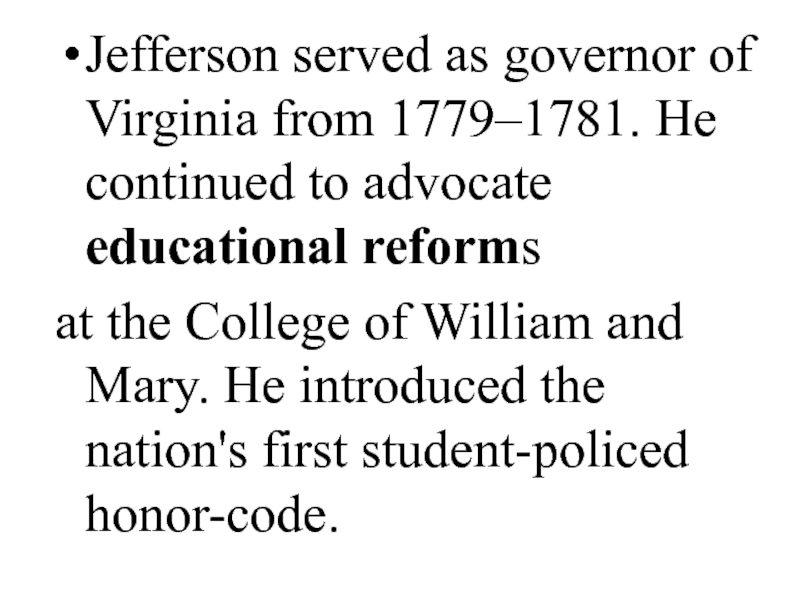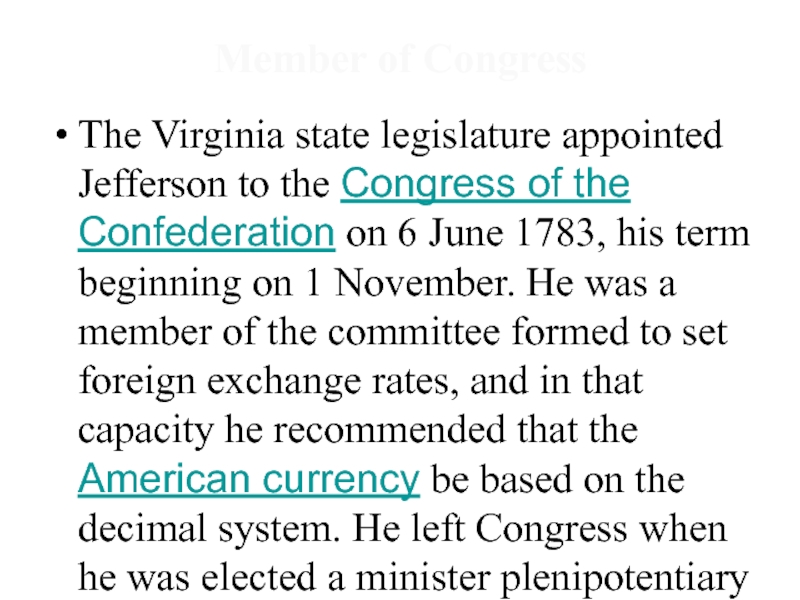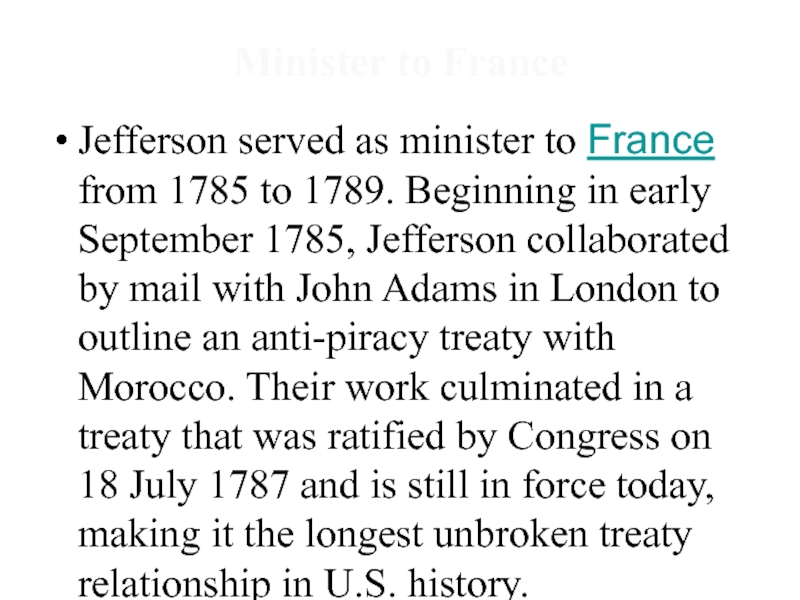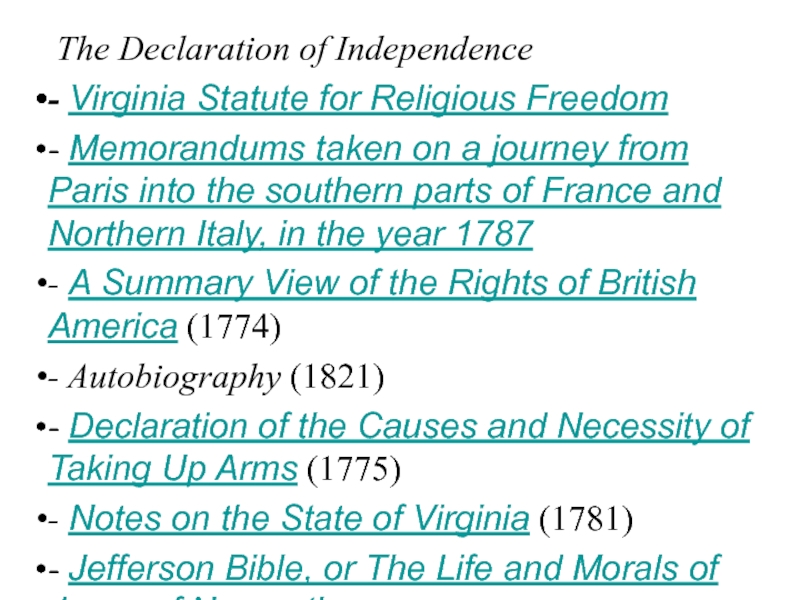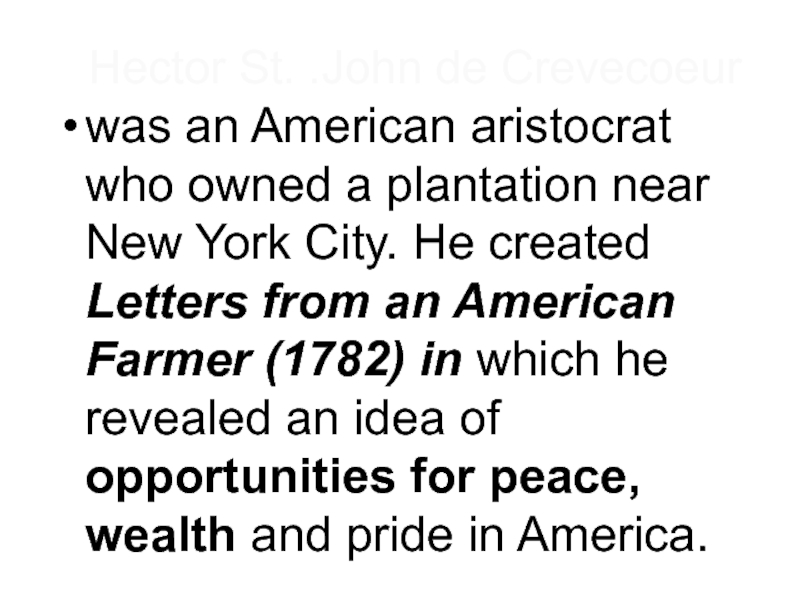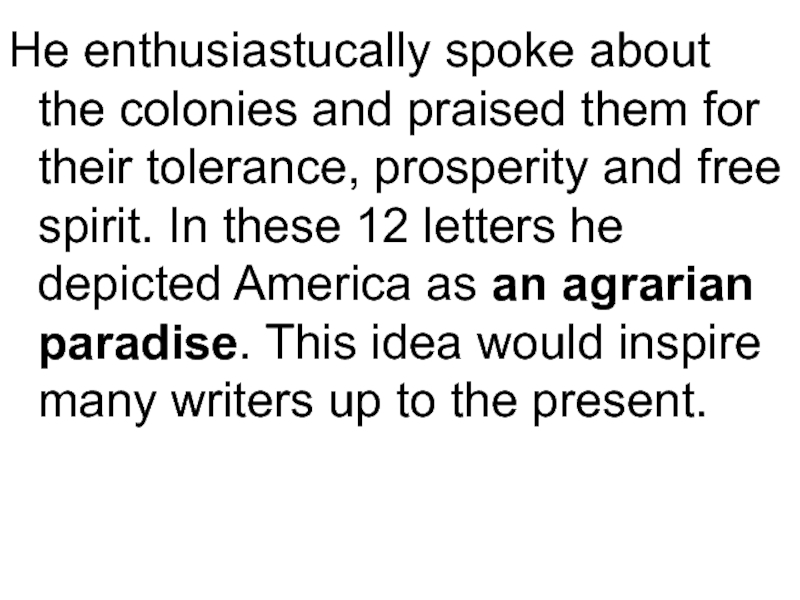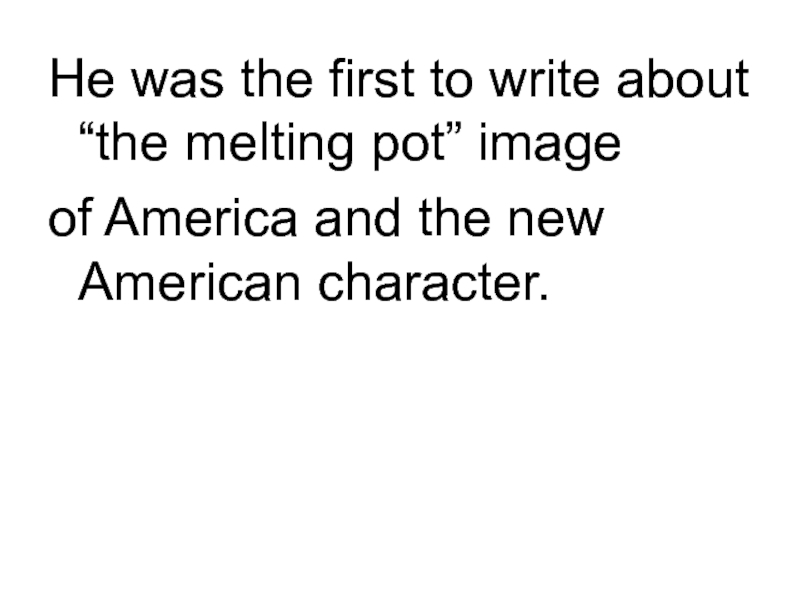- Главная
- Разное
- Дизайн
- Бизнес и предпринимательство
- Аналитика
- Образование
- Развлечения
- Красота и здоровье
- Финансы
- Государство
- Путешествия
- Спорт
- Недвижимость
- Армия
- Графика
- Культурология
- Еда и кулинария
- Лингвистика
- Английский язык
- Астрономия
- Алгебра
- Биология
- География
- Детские презентации
- Информатика
- История
- Литература
- Маркетинг
- Математика
- Медицина
- Менеджмент
- Музыка
- МХК
- Немецкий язык
- ОБЖ
- Обществознание
- Окружающий мир
- Педагогика
- Русский язык
- Технология
- Физика
- Философия
- Химия
- Шаблоны, картинки для презентаций
- Экология
- Экономика
- Юриспруденция
The Age of Reason in America. The Enlightenment in America презентация
Содержание
- 1. The Age of Reason in America. The Enlightenment in America
- 2. The Age of Reason, or the
- 3. Rationalism is the belief that people can
- 4. The emergence of modern science and the
- 5. Discoveries made by physical scientists and mathematicians
- 6. Scientific investigation seemed to show that
- 7. The Puritans saw God as actively
- 8. Sir Issac Newton (1642-1727), who discovered the
- 9. According to this view, God would not
- 10. God’s special gift to humanity was reason
- 11. This gift of reason enabled people to
- 12. The theoretical background for the Age of
- 13. In America pragmatism was characterized by an
- 14. The Age of Reason in America combined
- 15. From this mixture of ideas and
- 16. and the thinking behind the important
- 17. In the 1770s of the 18th century
- 18. This event of epoch-making significance had been
- 19. The spiritual life in the colonies during
- 20. which opposed themselves to the old colonial order and religious obscurantism.
- 21. The representatives of the Enlightenment set
- 22. American Enlightenment dealt a decisive blow upon
- 23. At the initial period the spread
- 24. In the 18th century the most interesting
- 25. and who wrote the Constitution of
- 26. Benjamin Franklin (1706-1790) The writings
- 27. Franklin was the first and greatest of
- 28. Franklin was born in Boston.
- 29. At the age of 12 he became
- 30. who published the Boston Gazette.
- 31. In 1723 Franklin moved to Philadelphia after a quarrel with his brother.
- 32. He entered the printing shop of
- 33. He stayed in London working for a London Printing House.
- 34. He wrote A Dissertation on
- 35. He returned to Philadelphia, established his own
- 36. It was his own great achievement
- 37. He constantly worked to develop his own skills, he created himself.
- 38. He founded a society of young artisans,
- 39. The aim of this society was self-education
- 40. His idea – to do good
- 41. During 25 years, beginning from 1732, Franklin published his famous Poor Richard’s Almanac
- 42. which contained information on meteorology and
- 43. The Almanac greatly contributed to the cause of the Enlightenment in America.
- 44. Franklin never left off his self-education.
- 45. In 1751-1752 he made his experiments
- 46. He organized a library and hospital in Philadelphia.
- 47. He became a prominent public man in
- 48. In 1757 he went to London as the representative of the American colonies.
- 49. During his life in England he
- 50. Taking the advantage of his official post
- 51. Back to America, in 1775, Franklin took part in the revolutionary events.
- 52. As a congressman he entered the
- 53. As a writer Franklin is remembered for
- 54. 2 parts Buildungsroman
- 55. The First part (1771) Is an
- 56. The Second part (1784) presents thoughts of
- 57. and to American history He writes about
- 58. Most of his works were printed in
- 59. In his works Franklin raises his
- 60. Some of his political essays bear a
- 61. He was involved in democratic activities and his broad-minded genius found appreciation.
- 62. Thomas Paine 1737 – 1809
- 63. The time shortly before and during the
- 64. He is one of the most popular
- 65. He came from an unlikely background. He was born in England
- 66. and he was the poorly educated
- 67. He spent his 37 years of life
- 68. and a government employee who examined goods and levied taxes on them.
- 69. In 1774, Paine was dismissed for attempting
- 70. Like many others he came to America to make a new start.
- 71. With a letter of introduction from Ben
- 72. In the disagreement between England and the
- 73. In January of 1776, he published
- 74. In this 47-page pamphlet, Paine denounced King
- 75. The pamphlet sold half a million copies
- 76. In 1776 Paine joined the Continental
- 77. During the journey he began writing
- 78. In these, he commented on the course
- 79. The first of these pamphlets was read
- 80. After the Revolution Paine lived peacefully in
- 81. Revolutionary times were over in America but
- 82. In France he composed The Rights
- 83. The Rights of Man was an impassioned
- 84. Although he was outside the country,
- 85. He was briefly celebrated as a hero of the French Revolution.
- 86. Soon he was imprisoned for being a
- 87. secured Paine’s release in 1794 by insisting that Paine was an American citizen
- 88. The first part of the last great
- 89. The Age of Reason was Paine’s statement
- 90. The book was controversial in America where
- 91. When the author of the book finally
- 92. Thomas Jefferson
- 94. In office March 4, 1801 – March 4, 1809 Preceded by John Adams Succeeded by James Madison
- 95. Thomas Jefferson was the third President of
- 96. The chief author of the Declaration
- 97. He was an influential Founding Father. Jefferson
- 98. He was an influential Founding Father. Jefferson
- 99. Thomas Jefferson was born on April 13,
- 100. Jefferson's father was Peter Jefferson, a planter and surveyor in Albemarle County.
- 101. His mother was the daughter of a
- 102. In 1752, Jefferson began attending a local
- 103. At 16 Jefferson entered the College of
- 104. He also improved his French, Greek, and
- 105. At 16 Jefferson entered the College of
- 106. After graduating in 1762 with highest honors,
- 107. Jefferson served as a delegate to the
- 108. Jefferson was appointed to a five-man
- 109. The committee selected Jefferson to write the
- 110. Jefferson showed his draft to the committee,
- 112. On July 4, 1776, the wording of
- 113. In John Trumbull's painting Declaration ofDeclaration of
- 114. Jefferson’s most important document in the political
- 115. He was the author of
- 116. Jefferson's revolutionary view on individual religious freedom
- 117. Jefferson was State legislator
- 118. Jefferson served as governor of Virginia from
- 119. The Virginia state legislature appointed Jefferson to
- 120. Jefferson served as minister to France from
- 121. Secretary of State (1790–1793) Election of 1796
- 122. The Declaration of Independence - Virginia
- 123. was an American aristocrat who owned a
- 124. He enthusiastucally spoke about the colonies and
- 125. He was the first to write about
- 126. THE END
Слайд 2The Age of Reason,
or the Enlightenment,
began in Europe with
the
rationalist philosophers
and scientists of the 17th century.
and scientists of the 17th century.
Слайд 3Rationalism is the belief that people can arrive at truth by
reason
rather than relying
on the authority of the past, on religious faith,
or intuition.
rather than relying
on the authority of the past, on religious faith,
or intuition.
Слайд 4The emergence of modern science and the scientific method had much
to do with this new emphasis and reason and free inquiry.
Слайд 5Discoveries made by physical scientists and mathematicians were changing the ways
people viewed the universe.
Слайд 6Scientific investigation seemed
to show that the universe
was organized according
to certain unchanging laws,
and that people could discover those laws through the use
of their reason.
Слайд 7The Puritans saw God
as actively and mysteriously involved in the
workings of
the universe;
the rationalists saw God differently.
the universe;
the rationalists saw God differently.
Слайд 8Sir Issac Newton (1642-1727), who discovered the laws of gravity, compared
God to a clockmaker who, having created the perfect mechanism of this universe, then left His creation to run on its own.
Слайд 9According to this view, God would not interfere with the operation
of this perfect mechanism, and it made no sense to ask Him to do so.
Слайд 10God’s special gift to humanity was reason – the ability to
think in an ordered, logical manner.
As the French philosopher and mathematician, Rene Descartes affirmed in the opening sentence of his work Discourse on Method (1637): “I think, therefore, I am.”
As the French philosopher and mathematician, Rene Descartes affirmed in the opening sentence of his work Discourse on Method (1637): “I think, therefore, I am.”
Слайд 11This gift of reason enabled people to discover both scientific and
spiritual truth.
In the rationalist view, all human beings were born with an innate ethical sense, and all had the ability to regulate and improve their own lives.
In the rationalist view, all human beings were born with an innate ethical sense, and all had the ability to regulate and improve their own lives.
Слайд 12The theoretical background for the Age of Reason, then took shape
in Europe in the work of such figures as Descartes, Newton, and John Locke.
Слайд 13In America pragmatism was characterized by an interest in the public
welfare and a willingness to experiment, to try things out, no matter what the authorities might say.
Слайд 14The Age of Reason in America combined common sense with ideas
from European thinkers. The American reading public displayed great interest in the works of English scientists, philosophers and writers, Newton, Swift, Locke and others. The writers of the French Enlightenment, Voltaire, Russeau were widely read in America.
Слайд 15 From this mixture of ideas and outlooks came much of
the triumph of 18th-century American life: the inventive and curious minds of Benjamin Franklin and Thomas Jefferson, the drive to improve living conditions, forms of government, and individual minds;
Слайд 16and the thinking behind
the important statement
“We hold these truths
to be self-evident”
(The Declaration of Independence, Thomas Jefferson).
Слайд 17In the 1770s of the 18th century the English colonies rebelled
against their parental colony. The War for Independence lasted for 8 years (1776-1783) and ended in the formation of a Federative Bourgeois Democratic Republic – the USA.
Слайд 18This event of epoch-making significance had been pre-determined by the whole
course of historical development of the colonial America.
Слайд 19The spiritual life in the colonies during that period was influenced
by the bourgeois Enlightenment –
a movement supported by all progressive forces of the country
Слайд 21The representatives
of the Enlightenment set themselves the task of disseminating
knowledge among the people and advocating revolutionary ideas.
They also participate in the War of Independence.
They also participate in the War of Independence.
Слайд 22American Enlightenment dealt a decisive blow upon the puritan traditions and
brought to life secular education and literature.
Слайд 23At the initial period
the spread of ideas
of the Enlightenment
was largely due to
journalism.
Слайд 24In the 18th century the most interesting writing was done by
the Founding Fathers, who led
the Revolution
of 1775-1783
the Revolution
of 1775-1783
Слайд 25and who wrote
the Constitution of 1789.
They were philosophers and
also wrote political pamphlets.
Слайд 26Benjamin Franklin
(1706-1790)
The writings
of Benjamin Franklin
show the Enlightenment spirit
in America.
Слайд 27Franklin was the first and greatest of American enlighteners.
He wrote
a great deal.
Almost all of his important works are short.
Almost all of his important works are short.
Слайд 28Franklin was born
in Boston.
He attended school
only for one
year and educated himself
by reading extensively.
by reading extensively.
Слайд 29At the age of 12 he became
an apprentice in the
printing house belonging
to his elder brother, James Franklin,
to his elder brother, James Franklin,
Слайд 35He returned to Philadelphia,
established his own press and
issued
The Pensylvania
Gazette in 1730s
Слайд 38He founded a society of young artisans, apprentices and traders, called
“Junta”,
the “Junta” club.
the “Junta” club.
Слайд 39The aim of this society was self-education and dissemination of knowledge.
The “Junta” later developed into the American Philosophical Society.
Слайд 40His idea – to do good
to people
He became a leader
in philanthropic,
scientific,
and political affairs
Слайд 42which contained information
on meteorology and agriculture alongside with
stories, fables,
proverbs.
Слайд 44Franklin never left off
his self-education.
He read extensively, studied foreign
languages and engaged in research work
in physics.
in physics.
Слайд 45In 1751-1752 he made
his experiments
on atmospheric electricity which brought
him world renown.
Franklin also participated in various public activities.
Franklin also participated in various public activities.
Слайд 47He became a prominent public man in the country,
and prior
to the war
was given high posts
in the colonial government.
was given high posts
in the colonial government.
Слайд 50Taking the advantage of his official post Franklin protested against
the
measures directed
by England against
the American colonies.
by England against
the American colonies.
Слайд 52As a congressman he entered
the committee which was
to draw
up
the DECLARATION OF INDEPENDENCE
the DECLARATION OF INDEPENDENCE
Слайд 53As a writer Franklin is remembered for his essays on a
variety of subjects and his Autobiography (1771-1790).
Слайд 55The First part (1771)
Is an entertaining description of his own
life up to his early manhood
Слайд 56The Second part (1784)
presents thoughts of a mature man.
His style
is serious. He writes about his contribution to America
Слайд 57and to American history
He writes about himself
“For the Improvement of
Others”
This autobiography of
the Father of the Yankees is of great value.
This autobiography of
the Father of the Yankees is of great value.
Слайд 58Most of his works were printed in his own almanac and
should be regarded as a valuable contribution to the cause of the American Enlightenment.
Слайд 59In his works Franklin raises
his voice against monarchy, slavery, racial
discrimination and extermination
of the Indians.
of the Indians.
Слайд 60Some of his political essays bear a marked
satirical character and
are directed against the British government.
Слайд 63The time shortly before and during the War for Independence
embraces
the activities
of Thomas Paine.
Слайд 64He is one of the most popular men of the Age
of Reason and
the most persuasive writer
of the American Revolution.
the most persuasive writer
of the American Revolution.
Слайд 67He spent his 37 years of life drifting through a number
of occupations: corset maker, grocer, tobacconist, school teacher,
Слайд 69In 1774, Paine was dismissed for attempting to organize
the employees
in demand
for higher wages which was an unusual activity in those days.
for higher wages which was an unusual activity in those days.
Слайд 71With a letter of introduction from Ben Franklin, whom he met
in London,
Paine went to Philadelphia, where he worked as
a journalist.
Paine went to Philadelphia, where he worked as
a journalist.
Слайд 72In the disagreement between England and the Colonies, he instantly identified
with the cause of the underdog.
Слайд 73In January of 1776,
he published the most important pamphlet
in
support of American independence: Common Sense.
Слайд 74In this 47-page pamphlet, Paine denounced King George III
as a
“royal brute” and asserted that a continent should not remain tied
to an island.
to an island.
Слайд 75The pamphlet sold half a million copies – in a country
whose total population was roughly
two and a quarter million.
two and a quarter million.
Слайд 76In 1776 Paine joined
the Continental Army as it retreated across
New Jersey to Philadelphia.
Слайд 78In these, he commented on the course of the war and
urged his countrymen not to give up the fight.
Слайд 79The first of these pamphlets was read to Washington’s troops in
December 1776, a few days before the recrossed the Delaware River to attack Trenton.
Слайд 80After the Revolution Paine lived peacefully in New York and New
Jersey until 1787 when he returned to Europe. There he became involved once more in radical revolutionary politics.
Слайд 81Revolutionary times were over in America but they were beginning in
Europe. On July 14, 1789, the French Revolution began in Paris with the storming of the Bastille by angry men led by Paine, who considered himself a citizen of the world, soon found a platform for his ideas.
Слайд 82In France he composed
The Rights of Man, a reply to
the English statesman Edmund Burke’s condemnation of the French Revolution.
Слайд 83The Rights of Man was an impassioned defense of republican government
and a call to the English people
to overthrow their king.
to overthrow their king.
Слайд 84Although he was outside
the country, Paine was tried for treason
and outlawed from England. He was safe in France from English law.
Слайд 86Soon he was imprisoned for being a citizen of an enemy
nation (England).
James Monroe, the American minister to France at that time,
James Monroe, the American minister to France at that time,
Слайд 88The first part of the last great work,
The Age of
Reason, appeared in 1794.
The second part was published two years later.
The second part was published two years later.
Слайд 89The Age of Reason was Paine’s statement
of belief and
an
explanation of the principles of deism.
Слайд 90The book was controversial in America where it was not fully
understood and was thought to be atheistic.
Слайд 91When the author of the book finally returned to America in
1802 he found himself an outcast.
Слайд 95 Thomas Jefferson was the third President of the United States (1801–1809)
and the principal author of the Declaration of Independence (1776).
Слайд 97He was an influential Founding Father. Jefferson envisioned America as a
great "Empire of Liberty" that would promote republicanism.
Thomas Jefferson was the third President of the United States (1801–1809) and the principal author of the Declaration of Independence (1776). The chief author of the Declaration of Independence – was an important writer.
Thomas Jefferson was the third President of the United States (1801–1809) and the principal author of the Declaration of Independence (1776). The chief author of the Declaration of Independence – was an important writer.
Слайд 98He was an influential Founding Father. Jefferson envisioned America as a
great "Empire of Liberty"
that would promote republicanism.
that would promote republicanism.
Слайд 99Thomas Jefferson was born on April 13, 1743 in a family
closely related to some of the most prominent individuals in Virginia.
He was the third of ten children.
He was the third of ten children.
Слайд 101His mother was the daughter of a ship's captain and sometime
planter and granddaughter of wealthy English and Scottish gentry. Peter Jefferson was then appointed to the Colonelcy of the county, an important position at the time.
Слайд 102In 1752, Jefferson began attending a local school run by a
local Scottish Presbyterian minister. At the age of nine, Jefferson began studying Latin, Greek, and French; he learned to ride horses, and began to appreciate the study of nature.
Слайд 103At 16 Jefferson entered the College of William and Mary in
Williamsburg, and for two years he studied mathematics, metaphysics, and philosophy, including John Locke, Francis Bacon, and Isaac Newton.
Слайд 104He also improved his French, Greek, and violin.
A diligent student,
Jefferson displayed an avid curiosity
in all fields.
Слайд 105At 16 Jefferson entered the College of William and Mary in
Williamsburg, and for two years he studied mathematics, metaphysics, and philosophy under Professor William Small, who introduced the enthusiastic Jefferson to the writings of the British Empiricists, including John Locke, Francis Bacon, and Isaac Newton. He also improved his French, Greek, and violin. A diligent student, Jefferson displayed an avid curiosity in all fields.
Слайд 106After graduating in 1762 with highest honors, he read law with
William & Mary law professor George Wythe and was admitted to the Virginia bar in 1767.
Слайд 107Jefferson served as a delegate to the Second Continental Congress beginning
in June 1775.
When Congress began considering
a RESOLUTION OF INDEPENDENCE
in June 1776,
When Congress began considering
a RESOLUTION OF INDEPENDENCE
in June 1776,
Слайд 108Jefferson was appointed to
a five-man committee to prepare a declaration
to accompany
the resolution.
the resolution.
Слайд 109The committee selected Jefferson to write the first draft because of
his reputation as a writer. The assignment was considered routine; no one at the time thought that it was a major responsibility. Jefferson completed a draft in consultation with other committee members, drawing on his own proposed draft of the Virginia Constitution, George Mason's draft of the Virginia Declaration of Rights, and other sources.
Слайд 110Jefferson showed his draft to the committee, which made some final
revisions, and then presented it to Congress on June 28, 1776. After voting in favor of the resolution of independence on July 2, Congress turned its attention to the declaration. Over several days of debate, Congress made a few changes in wording and deleted nearly a fourth of the text, most notably a passage critical of the slave trade, changes that Jefferson resented.
Слайд 112On July 4, 1776, the wording of the Declaration of Independence
was approved. The Declaration would eventually become Jefferson's major claim to fame, and his eloquent preamble became an enduring statement of human rights.
Слайд 113 In John Trumbull's painting Declaration ofDeclaration of Declaration of Independence, the
five-man drafting committee is presenting its work to the Continental Congress. Jefferson is the tall figure in the center laying the Declaration on the desk.
Слайд 114Jefferson’s most important document in the political history of the US
is also a fine work of literature. It is a clear and logical statement of why America wanted its independence, at the same time it is a significant literary heritage.
Слайд 116Jefferson's revolutionary view on individual religious freedom and protection from government
authority have generated much interest with modern scholars.
Слайд 118Jefferson served as governor of Virginia from 1779–1781. He continued to
advocate educational reforms
at the College of William and Mary. He introduced the nation's first student-policed honor-code.
at the College of William and Mary. He introduced the nation's first student-policed honor-code.
Слайд 119The Virginia state legislature appointed Jefferson to the Congress of the
Confederation on 6 June 1783, his term beginning on 1 November. He was a member of the committee formed to set foreign exchange rates, and in that capacity he recommended that the American currency be based on the decimal system. He left Congress when he was elected a minister plenipotentiary on 7 May 1784.
Member of Congress
Слайд 120Jefferson served as minister to France from 1785 to 1789. Beginning
in early September 1785, Jefferson collaborated by mail with John Adams in London to outline an anti-piracy treaty with Morocco. Their work culminated in a treaty that was ratified by Congress on 18 July 1787 and is still in force today, making it the longest unbroken treaty relationship in U.S. history.
Minister to France
Слайд 121Secretary of State (1790–1793)
Election of 1796 and Vice Presidency
As the Democratic-Republican
candidate in 1796 he lost to John Adams, but had enough electoral votes to become Vice President (1797–1801). He wrote a manual of parliamentary procedure, but otherwise avoided the Senate.
Presidency 1801–1809
Presidency 1801–1809
Слайд 122 The Declaration of Independence
- Virginia Statute for Religious Freedom
- Memorandums
taken on a journey from Paris into the southern parts of France and Northern Italy, in the year 1787
- A Summary View of the Rights of British America (1774)
- Autobiography (1821)
- Declaration of the Causes and Necessity of Taking Up Arms (1775)
- Notes on the State of Virginia (1781)
- Jefferson Bible, or The Life and Morals of Jesus of Nazareth
- Manual of Parliamentary Practice for the Use of the Senate of the United States (1801)
- A Summary View of the Rights of British America (1774)
- Autobiography (1821)
- Declaration of the Causes and Necessity of Taking Up Arms (1775)
- Notes on the State of Virginia (1781)
- Jefferson Bible, or The Life and Morals of Jesus of Nazareth
- Manual of Parliamentary Practice for the Use of the Senate of the United States (1801)
Слайд 123was an American aristocrat who owned a plantation near New York
City. He created Letters from an American Farmer (1782) in which he revealed an idea of opportunities for peace, wealth and pride in America.
Hector St. .John de Crevecoeur
Слайд 124He enthusiastucally spoke about the colonies and praised them for their
tolerance, prosperity and free spirit. In these 12 letters he depicted America as an agrarian paradise. This idea would inspire many writers up to the present.
Слайд 125He was the first to write about “the melting pot” image
of America and the new American character.
